文章目录
上一篇《【SpringBoot3.0源码】启动流程源码解析 • 上》,主要讲解了new SpringApplication()设置了一些初始化器和监听器,接下来我们讲解下run方法的调用。
步入run方法:
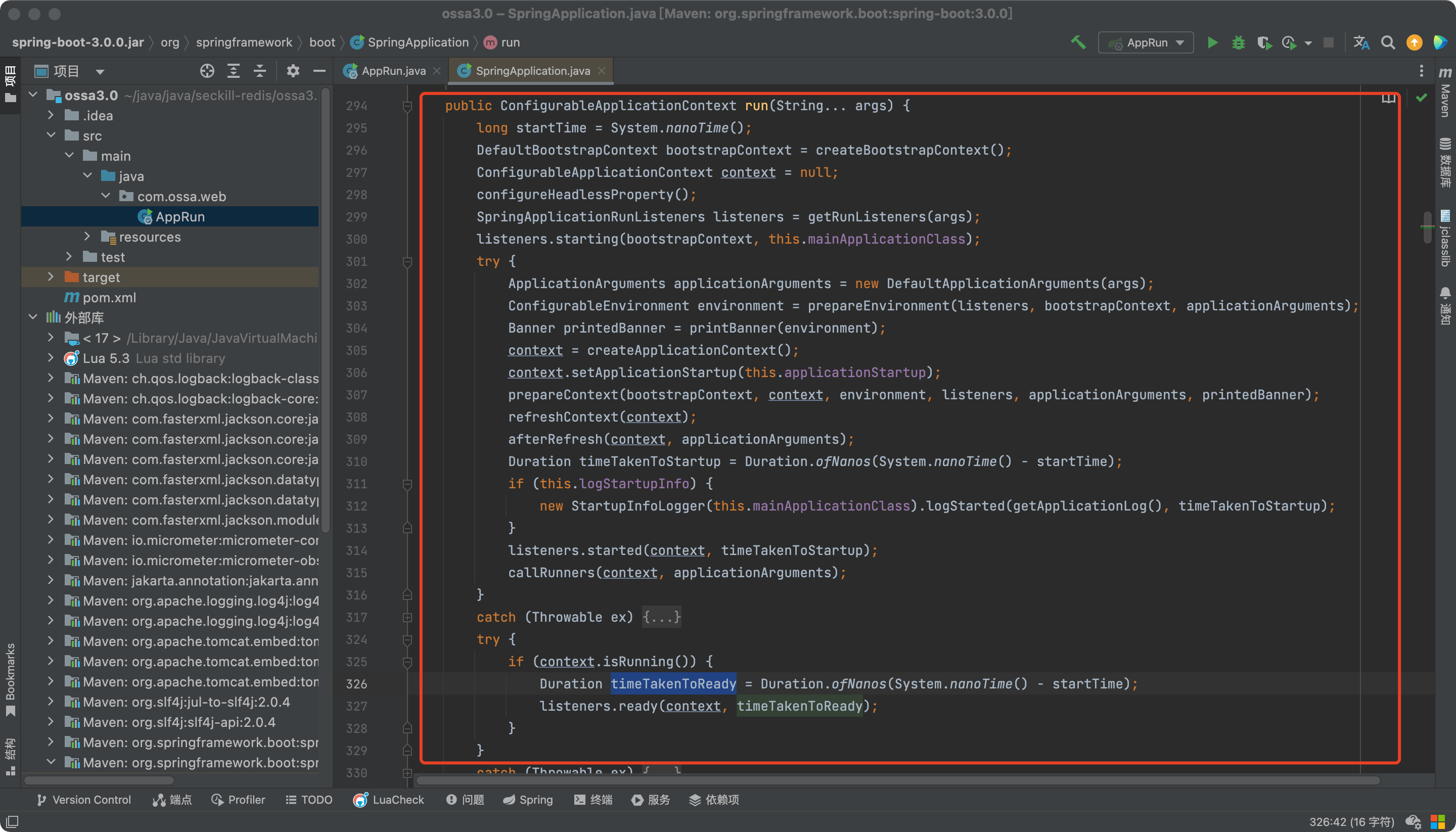
public ConfigurableApplicationContext run(String... args) {
// 记录时间
long startTime = System.nanoTime();
// 利用BootstrapRegistryInitializer初始化DefaultBootstrapContext对象
DefaultBootstrapContext bootstrapContext = createBootstrapContext();
ConfigurableApplicationContext context = null;
// 开启了Headless模式
configureHeadlessProperty();
// 获取监听器
SpringApplicationRunListeners listeners = getRunListeners(args);
// 发布ApplicationStartingEvent事件
listeners.starting(bootstrapContext, this.mainApplicationClass);
try {
// 根据命令行参数,实例化一个ApplicationArguments
ApplicationArguments applicationArguments = new DefaultApplicationArguments(args);
// 准备环境
ConfigurableEnvironment environment = prepareEnvironment(listeners, bootstrapContext, applicationArguments);
// 打印Banner
Banner printedBanner = printBanner(environment);
// 据webApplicationType创建不同的Spring上下文容器(有三种)
context = createApplicationContext();
context.setApplicationStartup(this.applicationStartup);
// 预初始化spring上下文
prepareContext(bootstrapContext, context, environment, listeners, applicationArguments, printedBanner);
// 刷新Spring容器
refreshContext(context);
afterRefresh(context, applicationArguments);
// 打印启动时间
Duration timeTakenToStartup = Duration.ofNanos(System.nanoTime() - startTime);
if (this.logStartupInfo) {
new StartupInfoLogger(this.mainApplicationClass).logStarted(getApplicationLog(), timeTakenToStartup);
}
// 发布ApplicationStartedEvent事件和AvailabilityChangeEvent事件
listeners.started(context, timeTakenToStartup);
// 获取Spring容器中的ApplicationRunner/CommandLineRunner类型的Bean,并执行run方法
callRunners(context, applicationArguments);
}
catch (Throwable ex) {
if (ex instanceof AbandonedRunException) {
throw ex;
}
// 发布ApplicationFailedEvent事件
handleRunFailure(context, ex, listeners);
throw new IllegalStateException(ex);
}
try {
if (context.isRunning()) {
Duration timeTakenToReady = Duration.ofNanos(System.nanoTime() - startTime);
// 发布ApplicationReadyEvent事件和AvailabilityChangeEvent事件
listeners.ready(context, timeTakenToReady);
}
}
catch (Throwable ex) {
if (ex instanceof AbandonedRunException) {
throw ex;
}
// 发布ApplicationFailedEvent事件
handleRunFailure(context, ex, null);
throw new IllegalStateException(ex);
}
return context;
}
初始化DefaultBootstrapContext
步入createBootstrapContext方法:
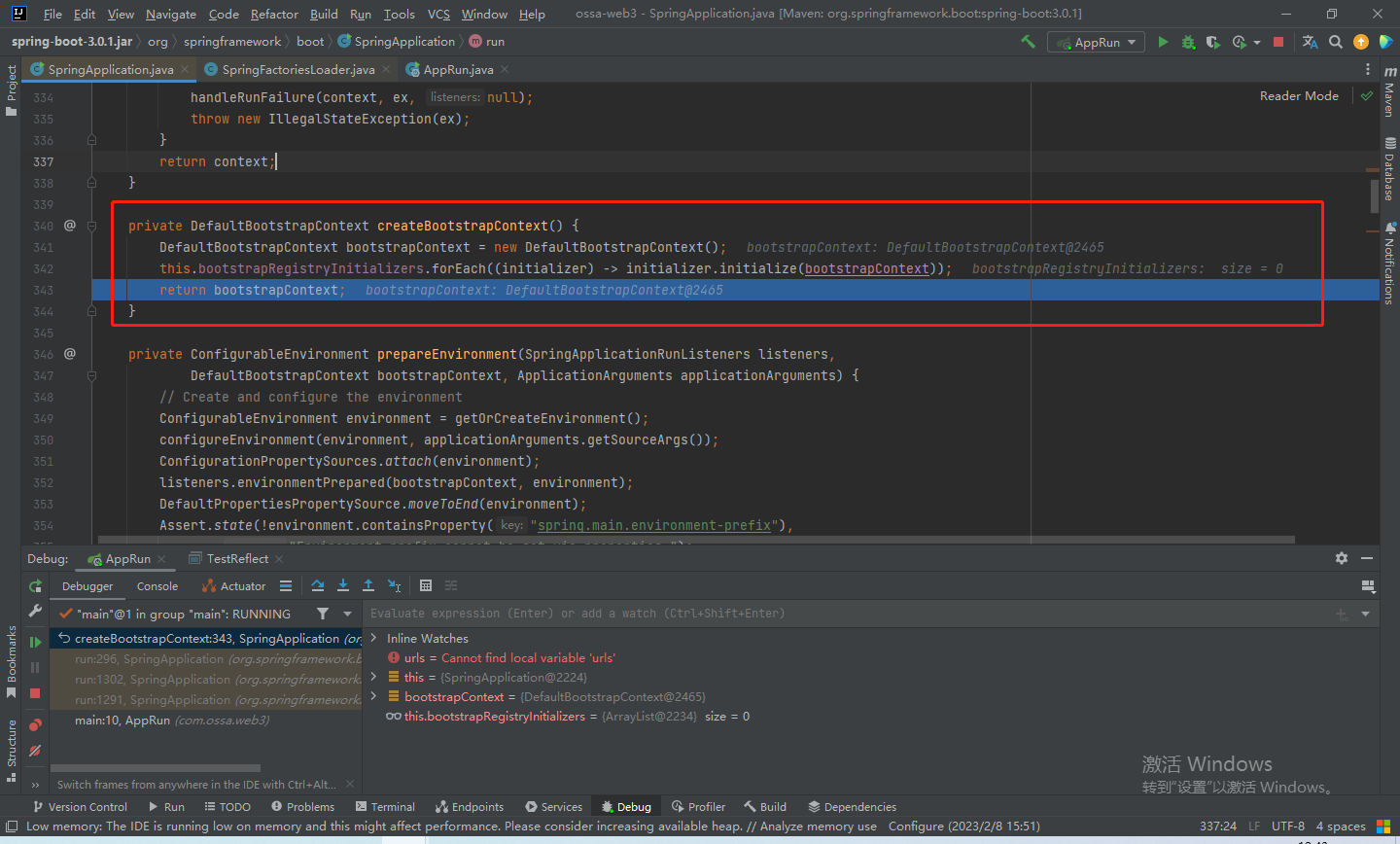
开启Headless模式
Headless模式是在缺少显示屏、键盘或者鼠标的系统配置。
步入configureHeadlessProperty方法:
private void configureHeadlessProperty() {
System.setProperty(SYSTEM_PROPERTY_JAVA_AWT_HEADLESS,
System.getProperty(SYSTEM_PROPERTY_JAVA_AWT_HEADLESS, Boolean.toString(this.headless)));
}
启用headless模式,需要使用setProperty方法去设置相应的系统属性。
System.setProperty(“java.awt.headless”,”true”)
如果想在一个相同的程序 中使用headless和传统环境,你可以使用下面的命令行来完成:
java -Djava.awt.headless=true
获取监听器并启动
SpringApplicationRunListeners listeners = getRunListeners(args);
listeners.starting(bootstrapContext, this.mainApplicationClass);
获取SpringApplicationRunListeners,SpringBoot提供了一个EventPublishingRunListener,它实现了SpringApplicationRunListener接口
Spring会利用这个类,发布一个ApplicationContextInitializedEvent事件,可以通过定义ApplicationListener来监听这个事件。
步入getRunListeners方法:调用getSpringFactoriesInstances方法获取监听器,这个方法前面前面讲过,因为在前面已经put进m缓存中,所以这里可以根据参数获取value值。
最后返回一个SpringApplicationRunListener实例。

接下来回去调用:
listeners.starting(bootstrapContext, this.mainApplicationClass);
步入starting方法:
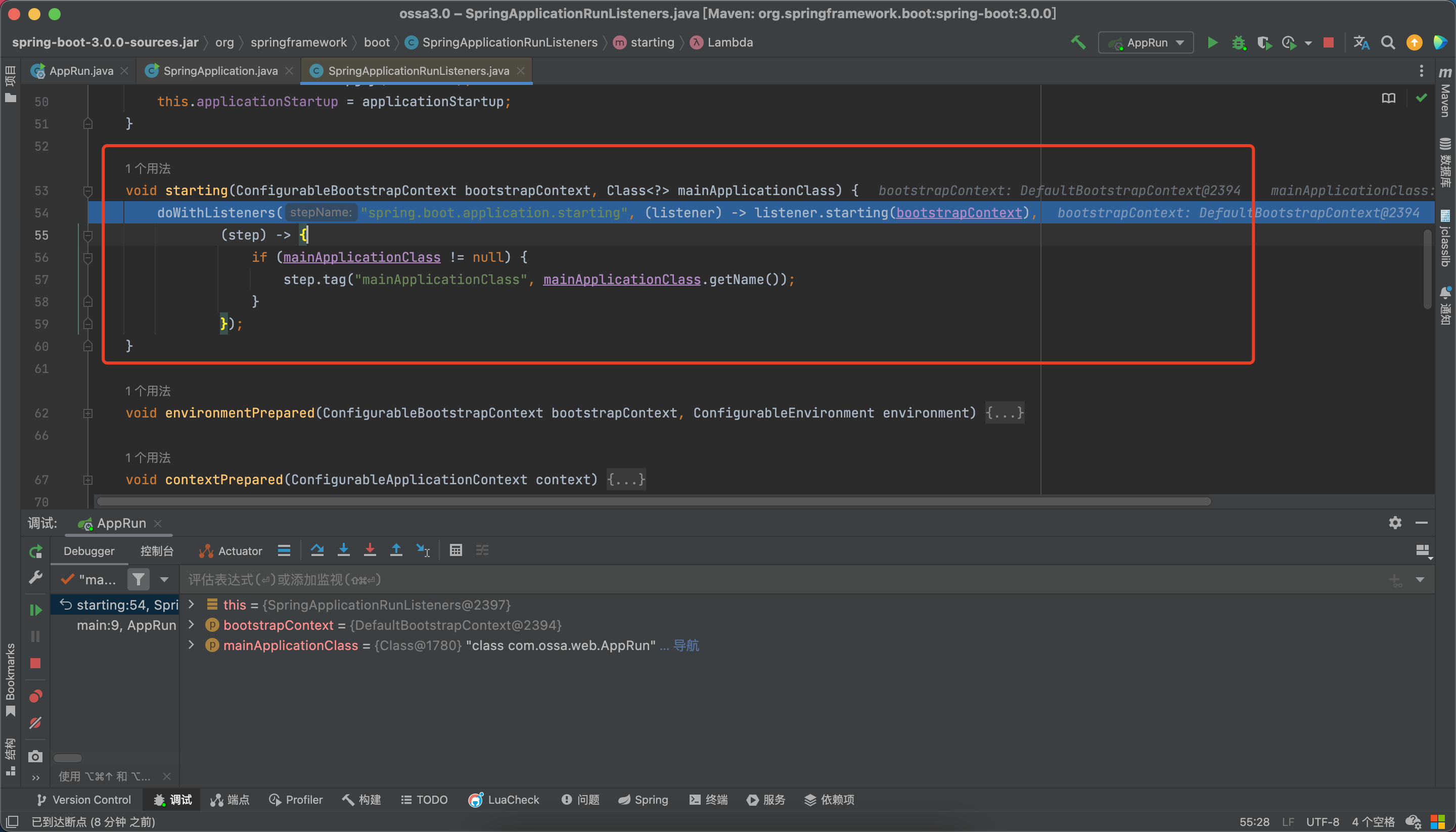
步入doWithListeners方法:

首先会调用listenerAction: (listener) -> listener.starting(bootstrapContext)
步入starting方法:
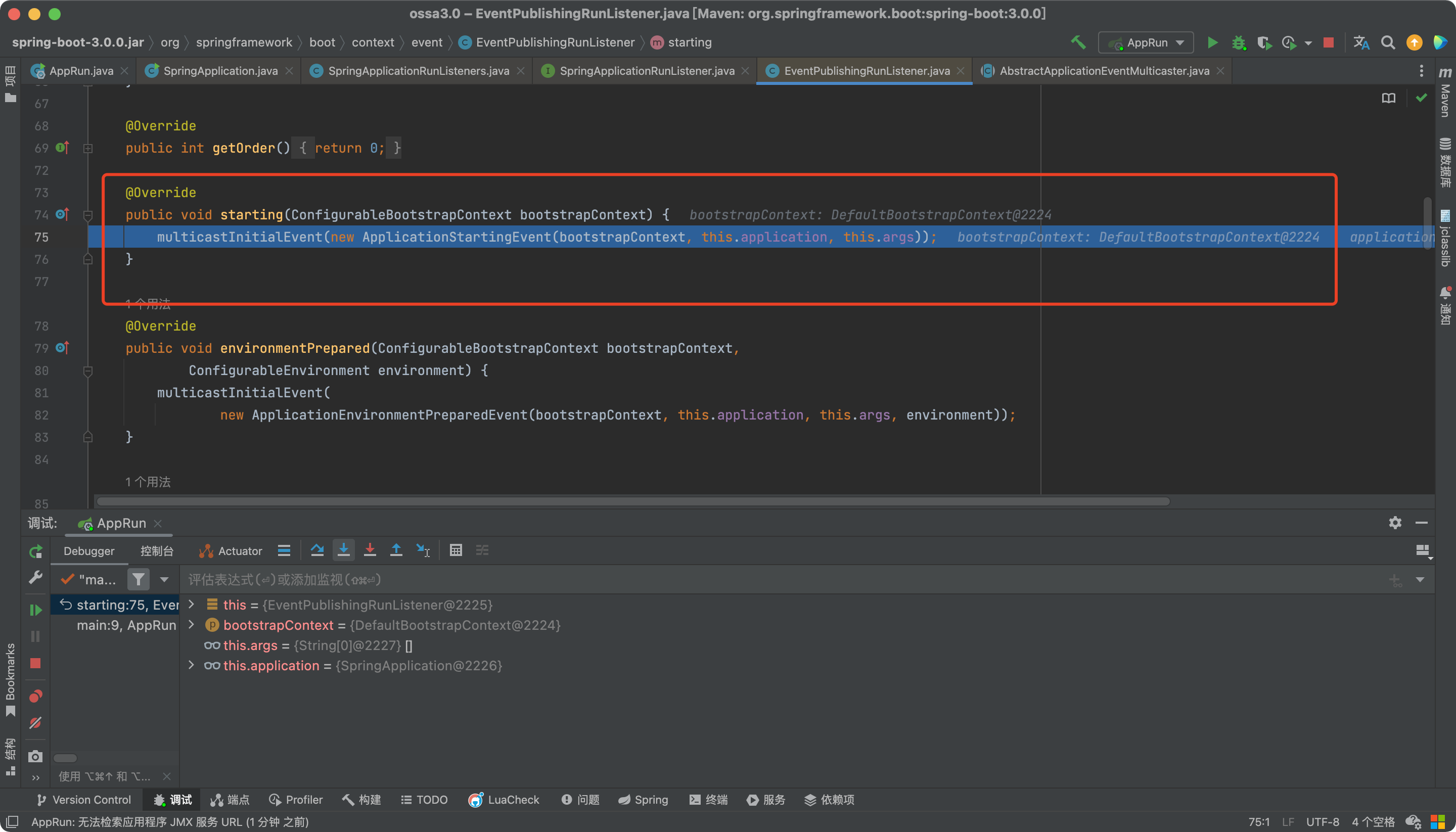
步入multicastInitialEvent方法:
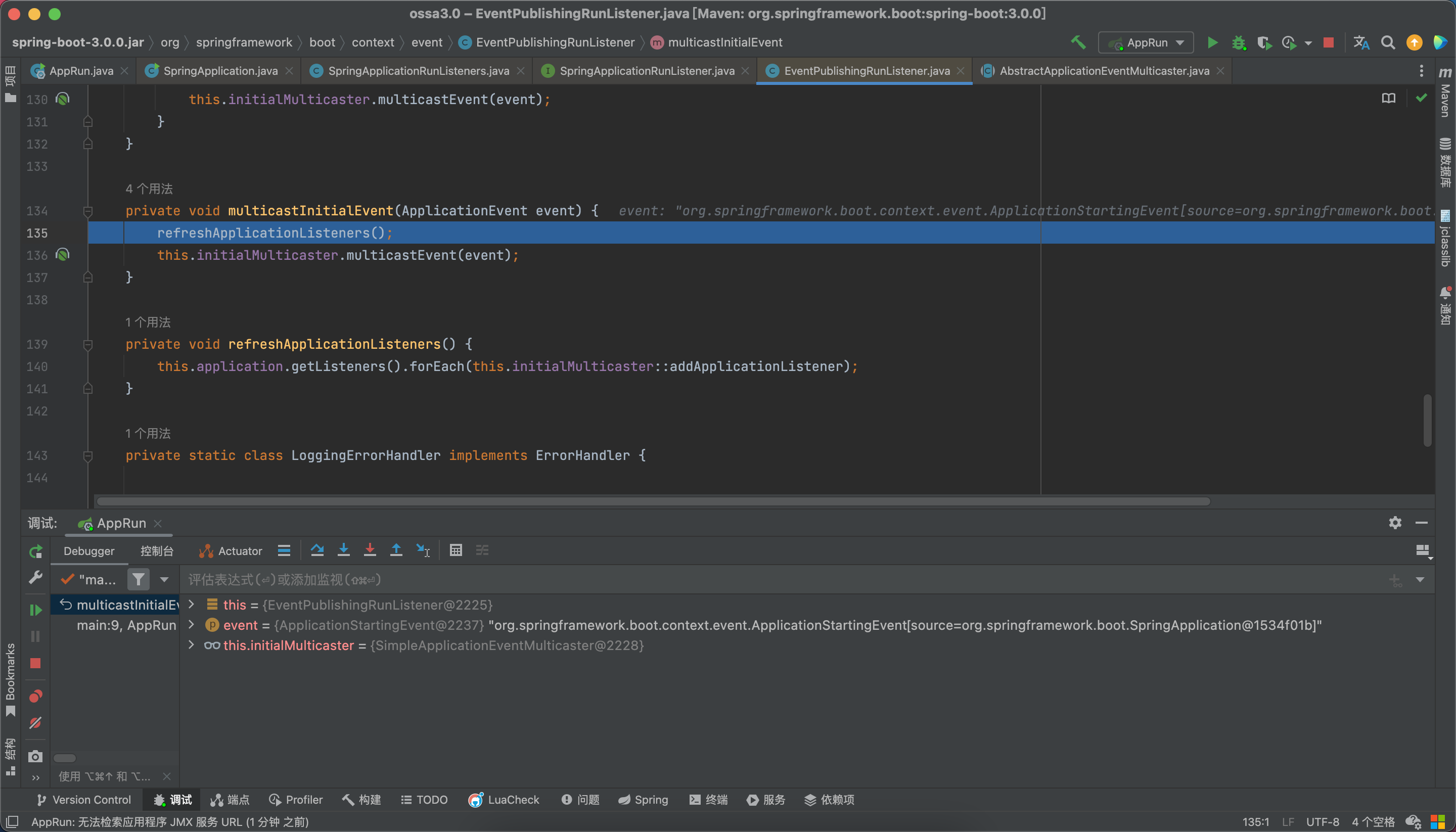
步入refreshApplicationListeners方法:
这7个监听器是我们之前加载到的:
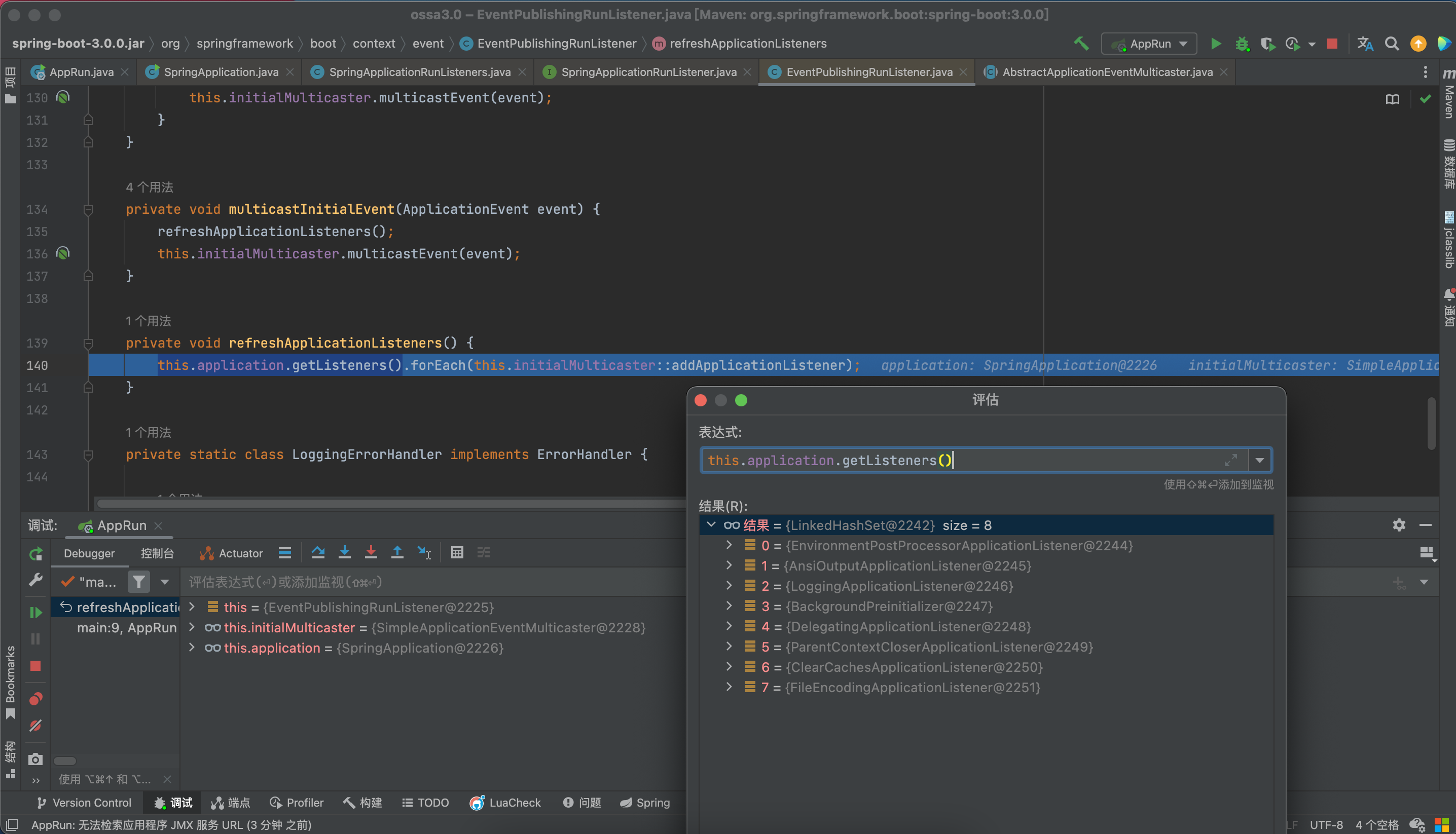
调用this.initialMulticaster::addApplicationListener方法:
显式删除代理的目标(如果已注册),以避免对同一侦听器进行双重调用。
add到applicationListeners的set集合中。
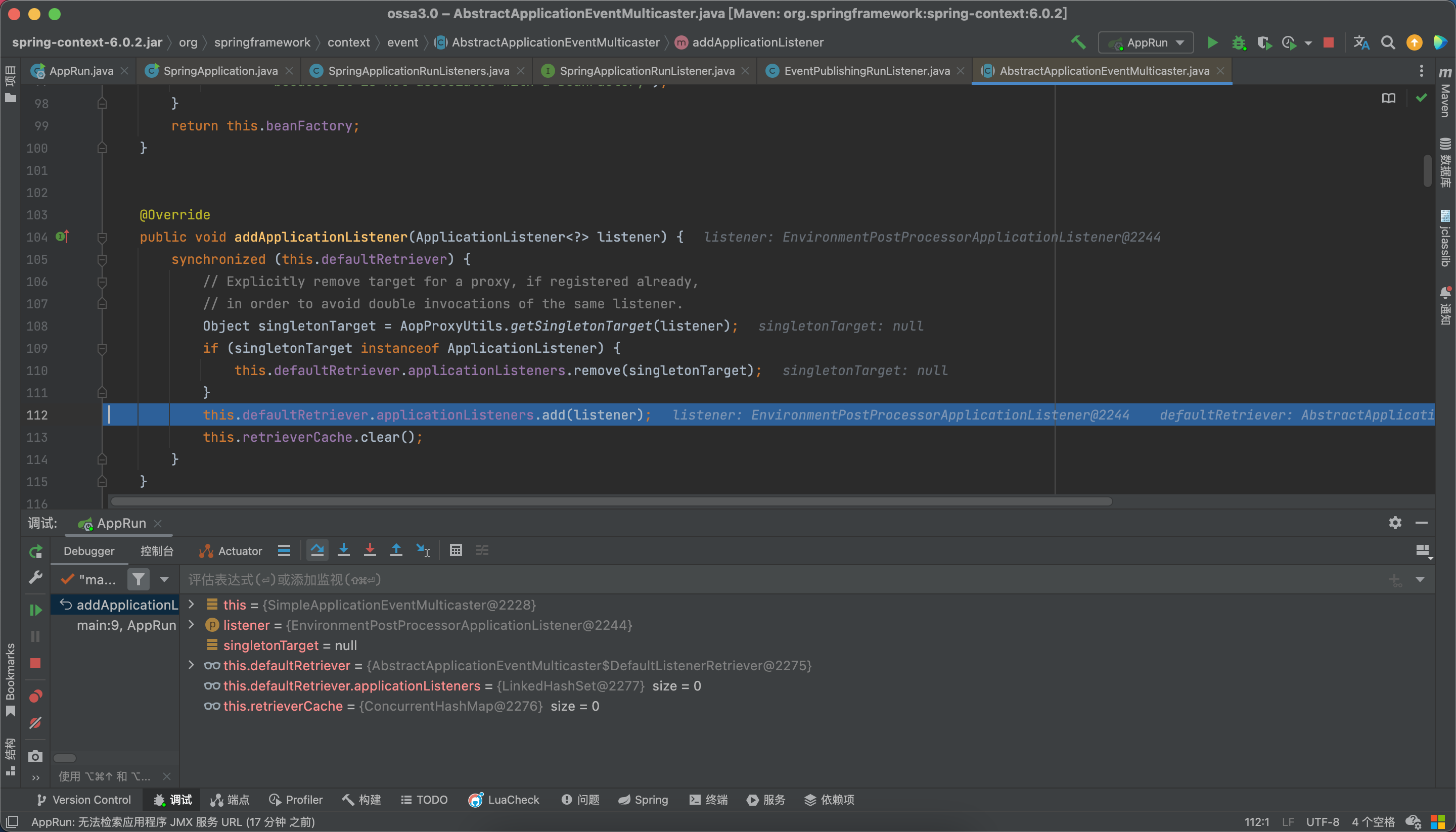
执行完返回:
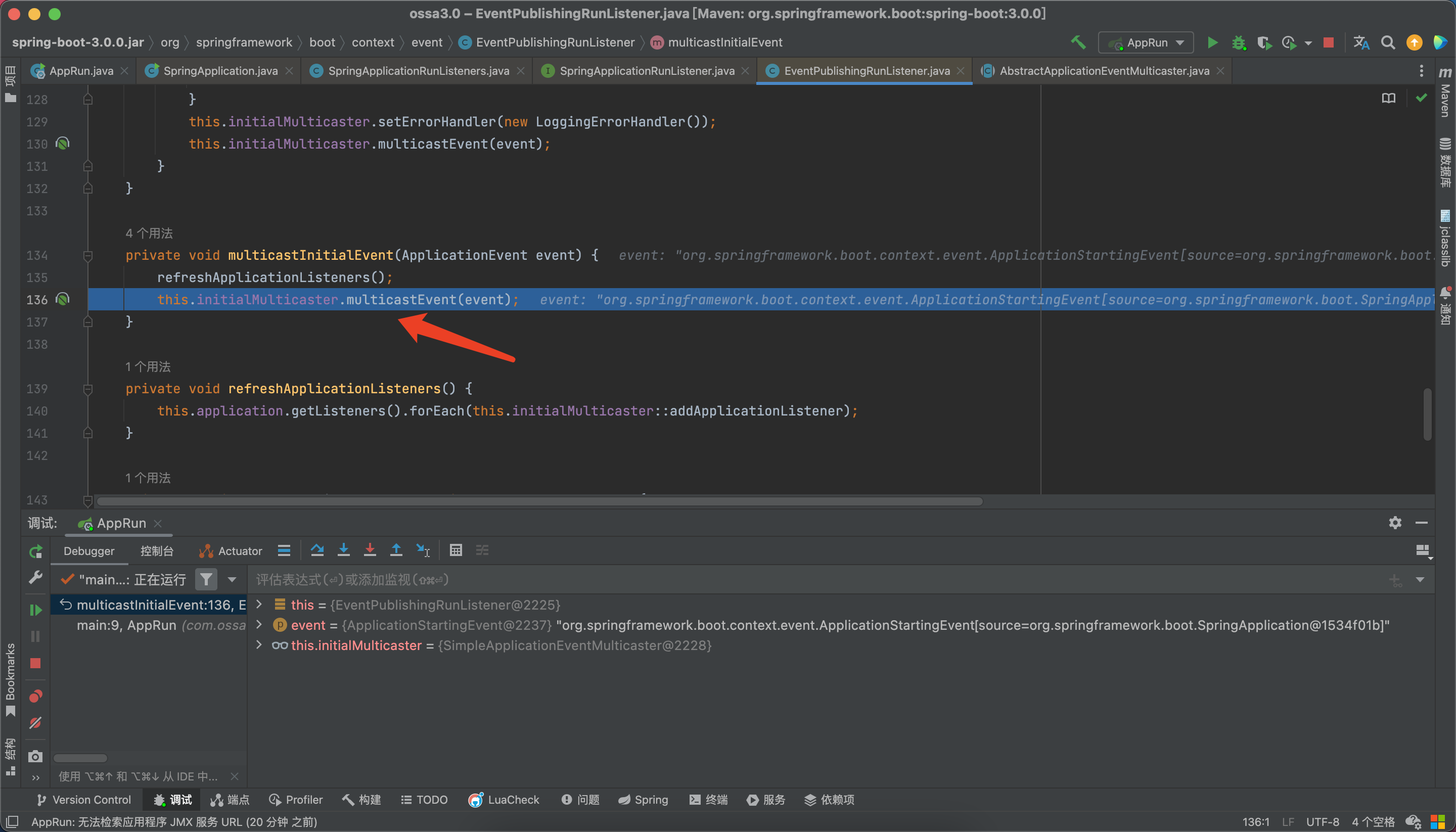
步入multicastEvent方法:
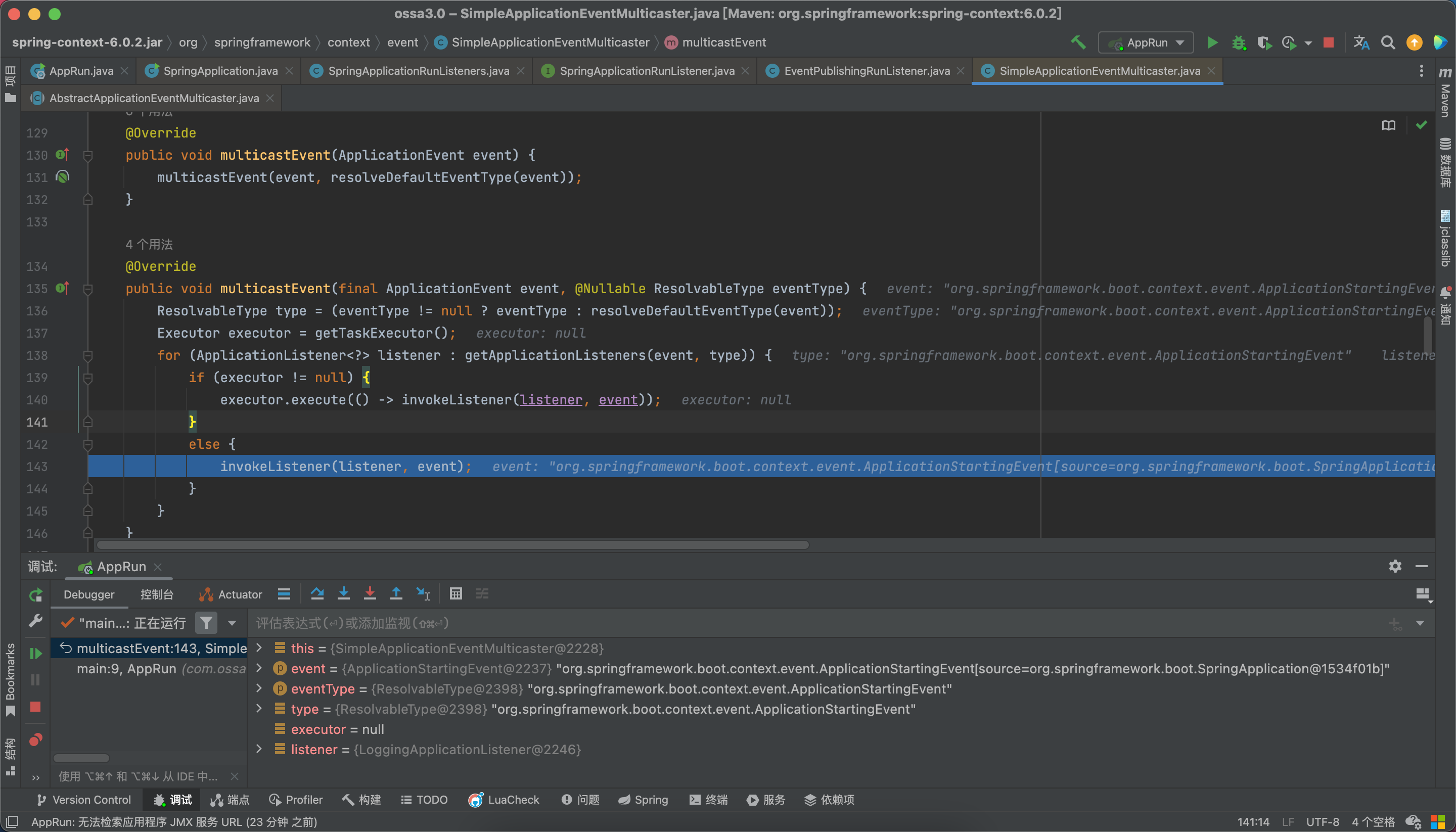
步入invokeListener方法:
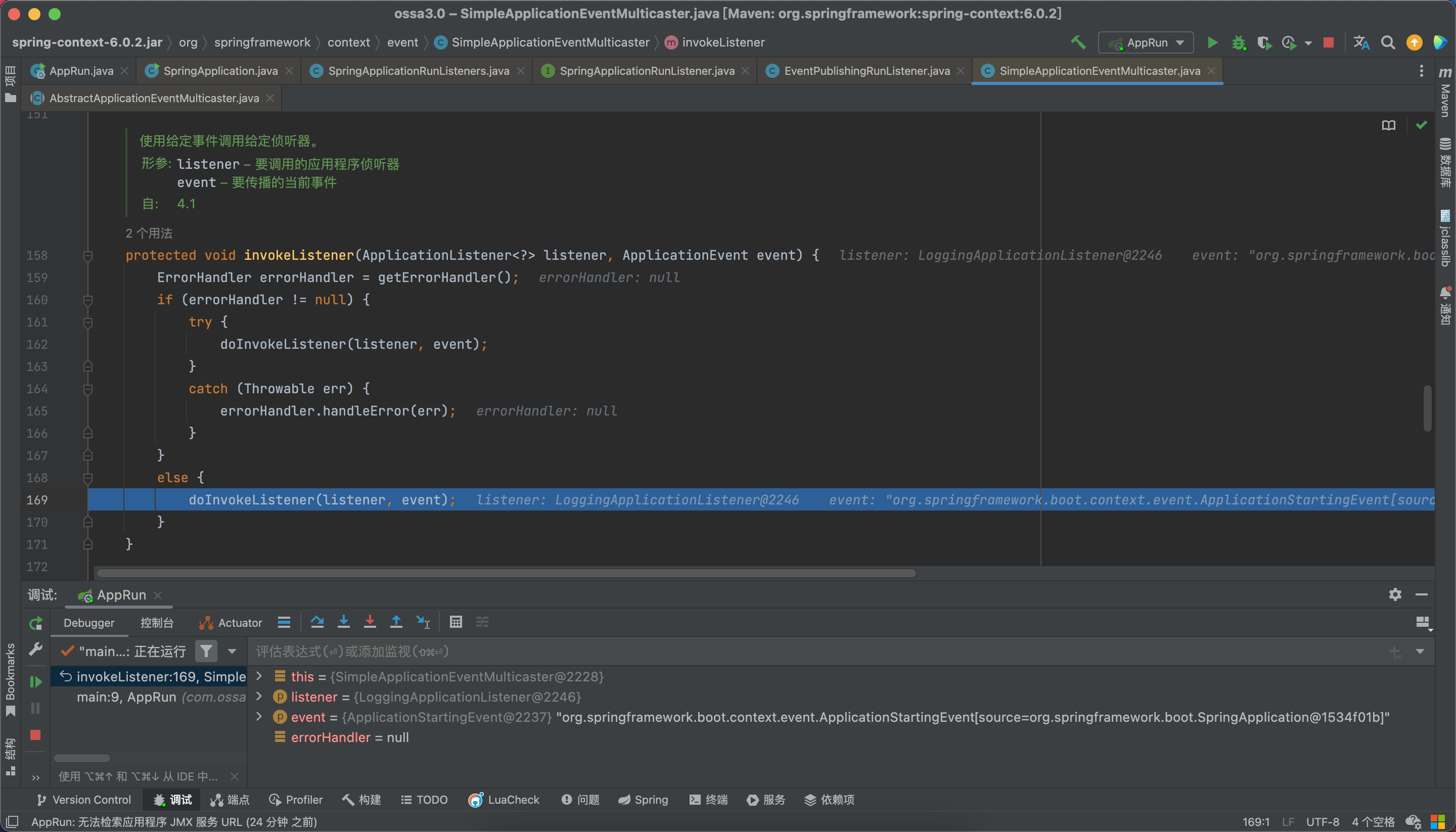
doInvokeListener
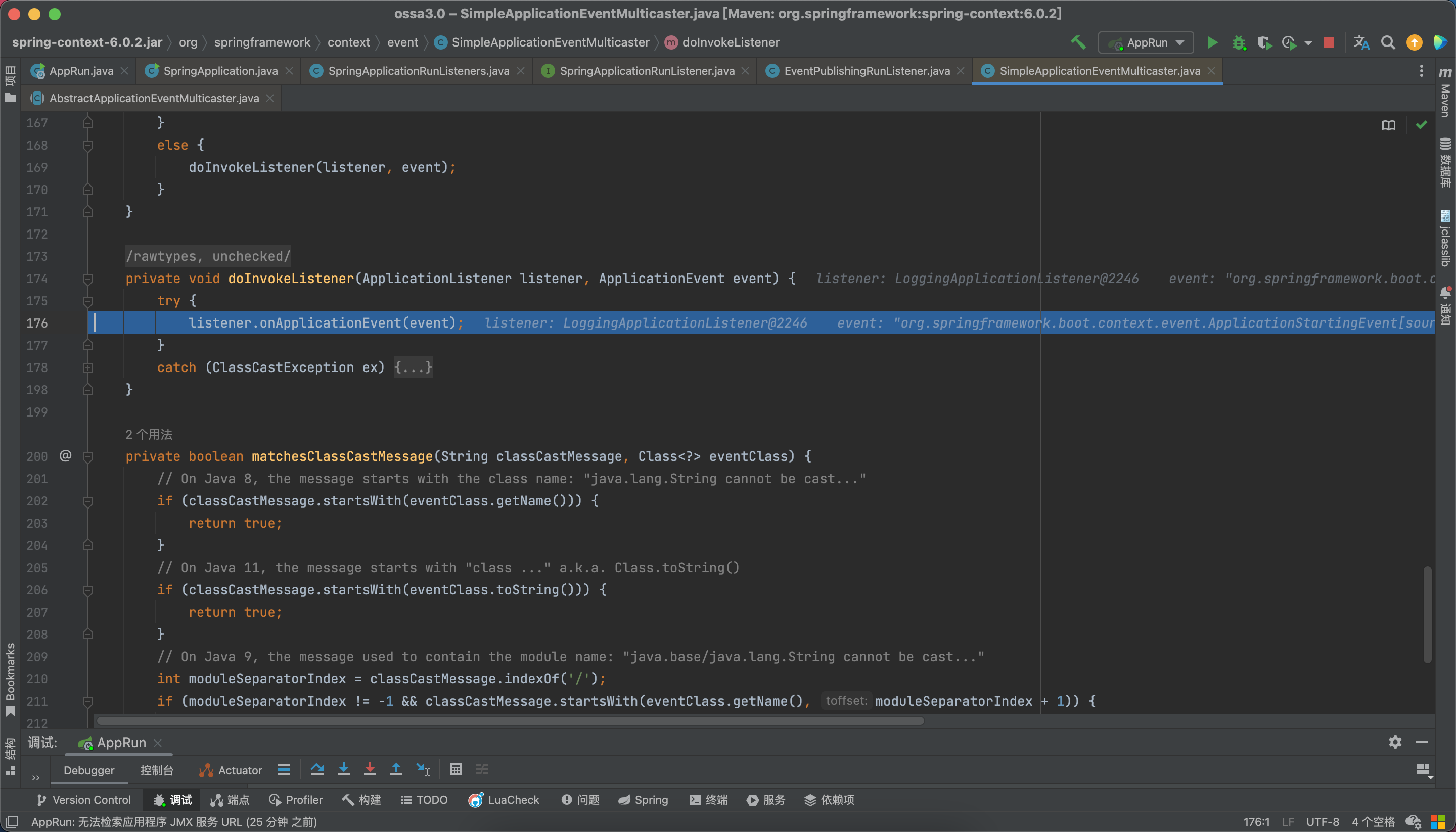
listener.onApplicationEvent(event);
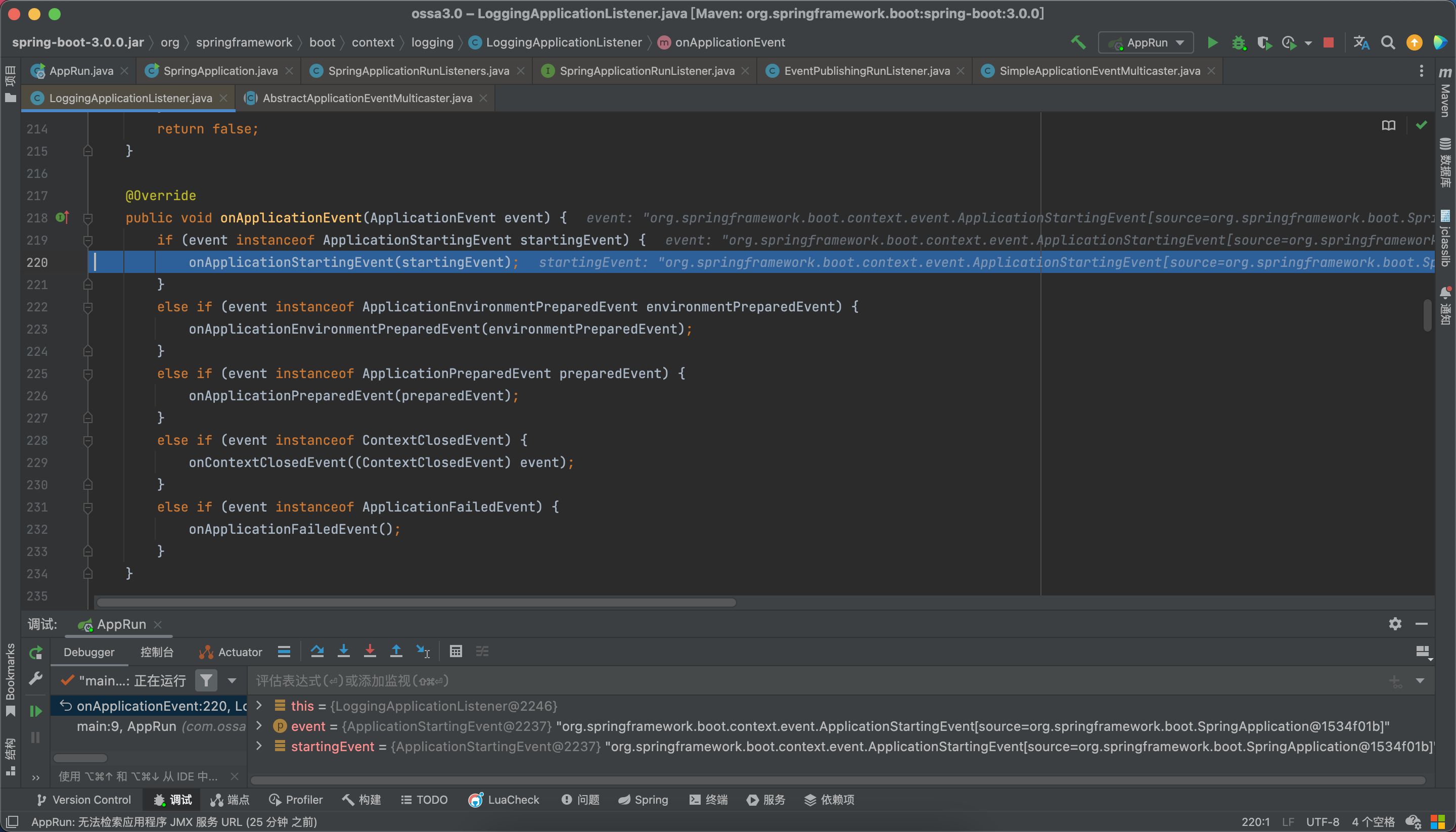
onApplicationStartingEvent
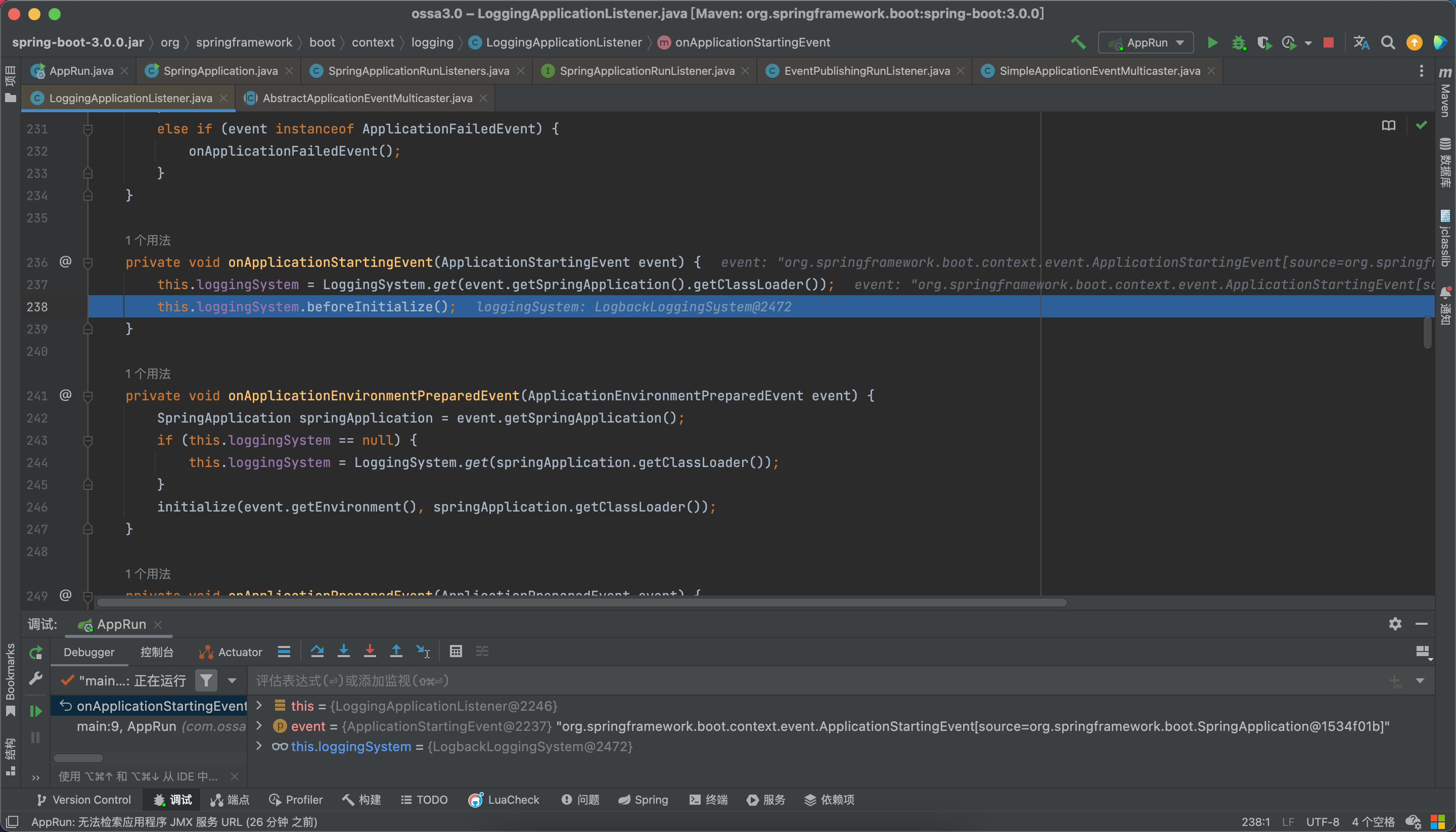
beforeInitialize

最后回到这里:

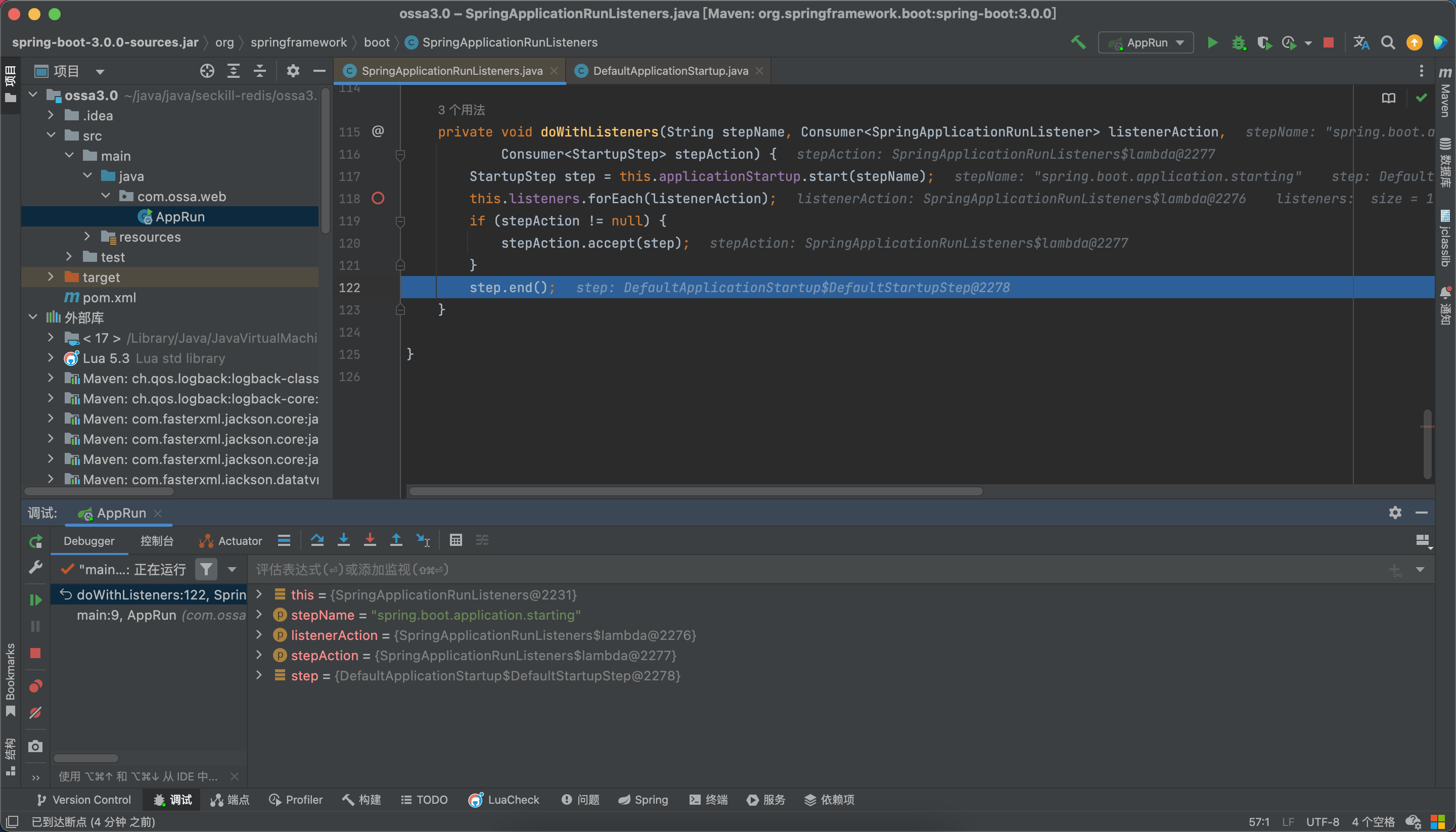
封装命令行参数
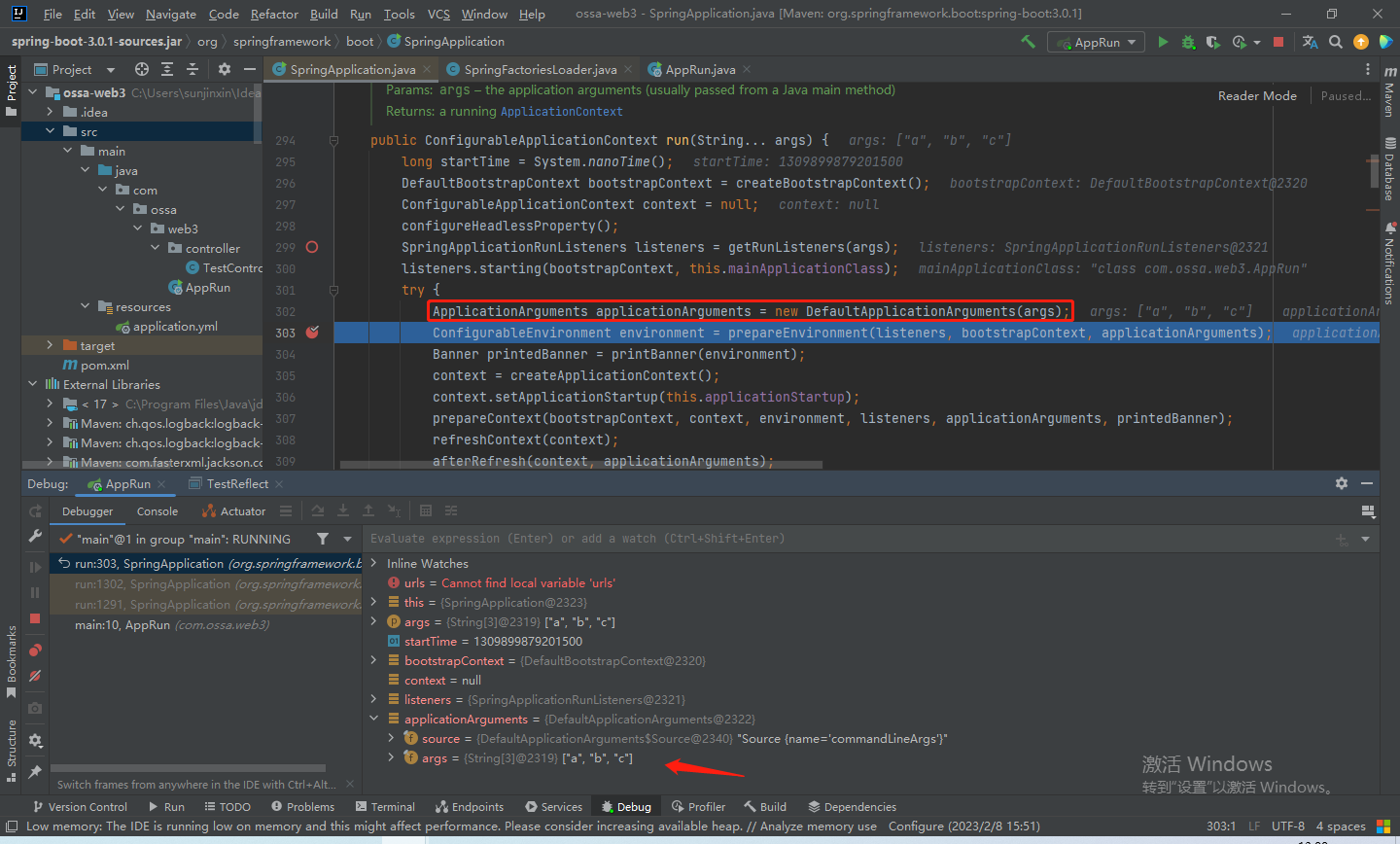
命令行参数配置:
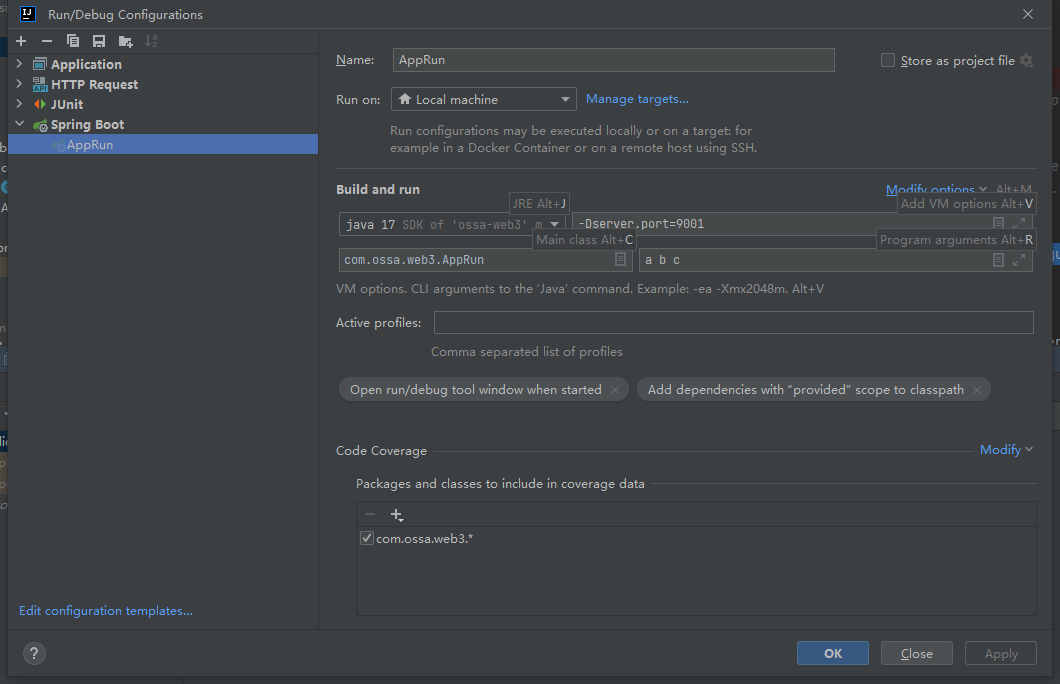
DefaultApplicationArguments构造方法:
public DefaultApplicationArguments(String... args) {
Assert.notNull(args, "Args must not be null");
this.source = new Source(args);
this.args = args;
}
准备环境
读取环境变量(操作系统的环境变量/JVM的环境变量),读取配置文件信息(基于监听器,会利用EventPublishingRunListener发布一个ApplicationEnvironmentPreparedEvent事件,默认会有一个EnvironmentPostProcessorApplicationListener来处理这个事件,当然也可以通过自定义ApplicationListener来处理这个事件,当ApplicationListener接收到这个事件之后,就会解析application.properties、application.yml文件,并添加到Environment中。
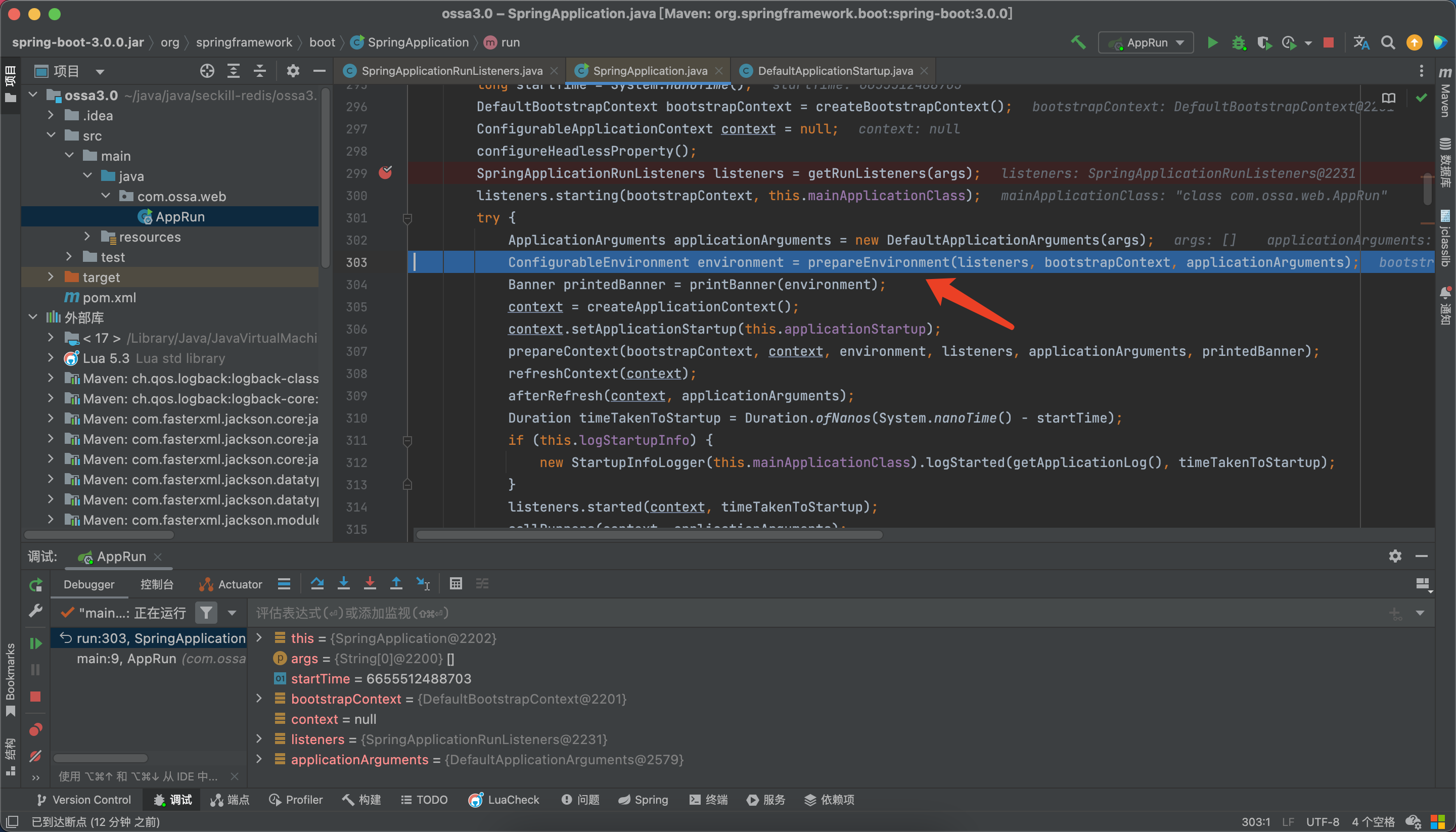
步入prepareEnvironment方法:
private ConfigurableEnvironment prepareEnvironment(SpringApplicationRunListeners listeners,
DefaultBootstrapContext bootstrapContext, ApplicationArguments applicationArguments) {
// 根据不同的web类型创建不同实现的Environment对象,读取:java环境变量和系统环境变量
ConfigurableEnvironment environment = getOrCreateEnvironment();
// 将命令行参数读取环境变量中
configureEnvironment(environment, applicationArguments.getSourceArgs());
// 将@PropertieSource的配置信息 放在第一位,它的优先级是最低的
ConfigurationPropertySources.attach(environment);
// 发布了ApplicationEnvironmentPreparedEvent 的监听器 读取了全局配置文件
listeners.environmentPrepared(bootstrapContext, environment);
DefaultPropertiesPropertySource.moveToEnd(environment);
Assert.state(!environment.containsProperty("spring.main.environment-prefix"),
"Environment prefix cannot be set via properties.");
// 将所有spring.main 开头的配置信息绑定到SpringApplication中
bindToSpringApplication(environment);
if (!this.isCustomEnvironment) {
EnvironmentConverter environmentConverter = new EnvironmentConverter(getClassLoader());
environment = environmentConverter.convertEnvironmentIfNecessary(environment, deduceEnvironmentClass());
}
// 更新PropertySources配置
ConfigurationPropertySources.attach(environment);
return environment;
}

根据不同的web类型创建不同实现的Environment对象,读取java环境变量和系统环境变量
ConfigurableEnvironment environment = getOrCreateEnvironment();
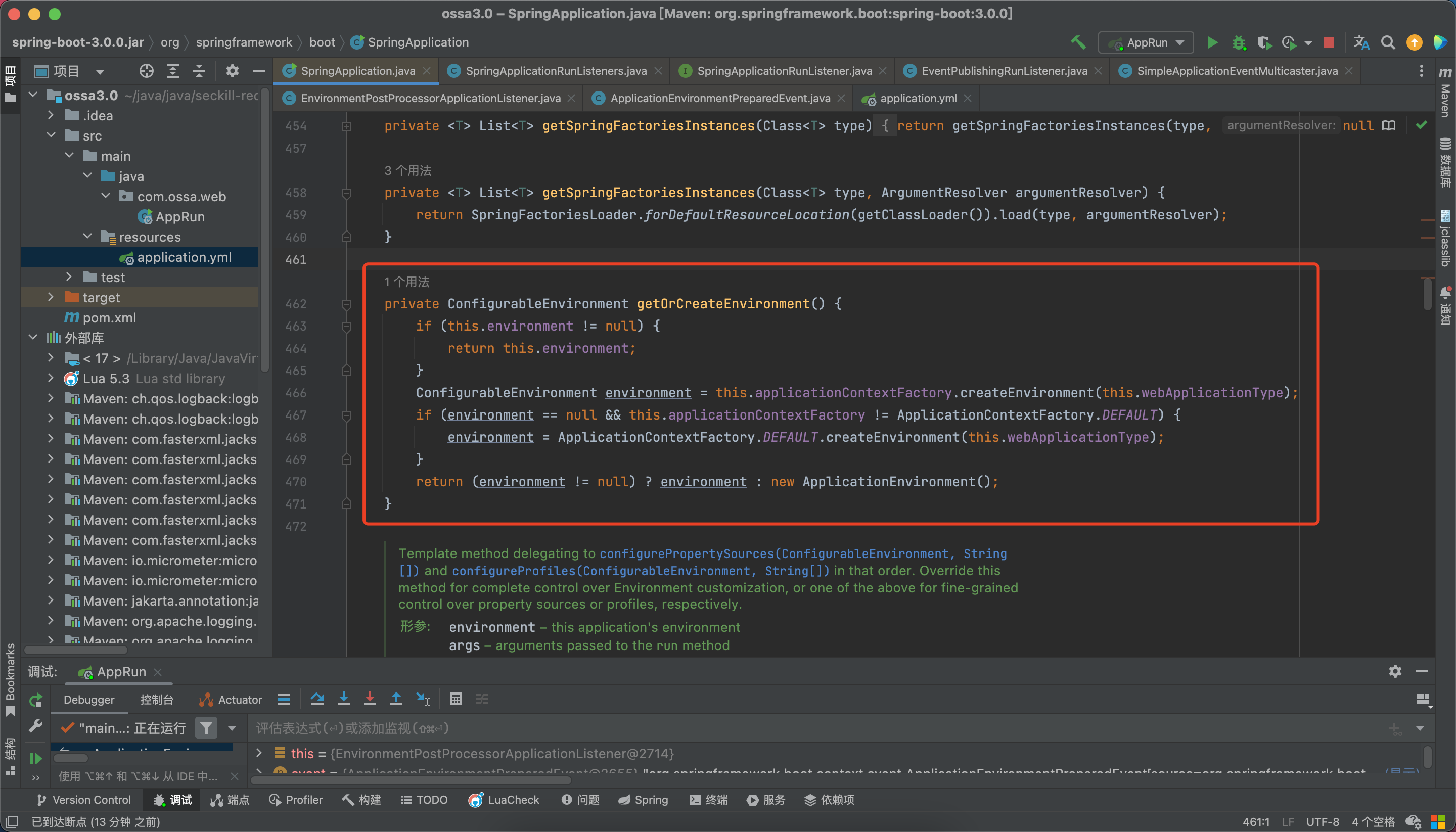
// 将命令行参数读取环境变量中
configureEnvironment(environment, applicationArguments.getSourceArgs());
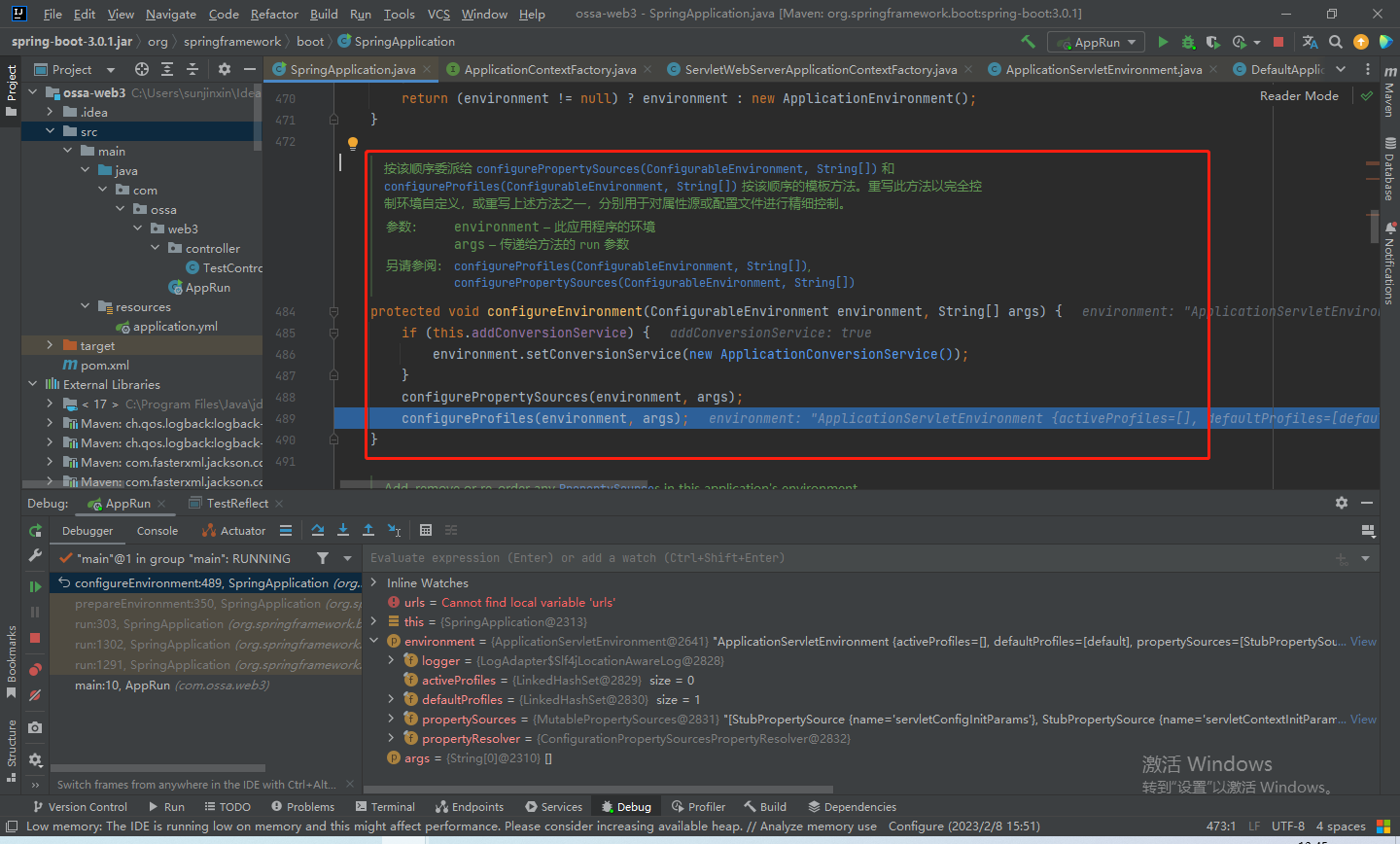
// 将@PropertieSource的配置信息 放在第一位,它的优先级是最低的
ConfigurationPropertySources.attach(environment);
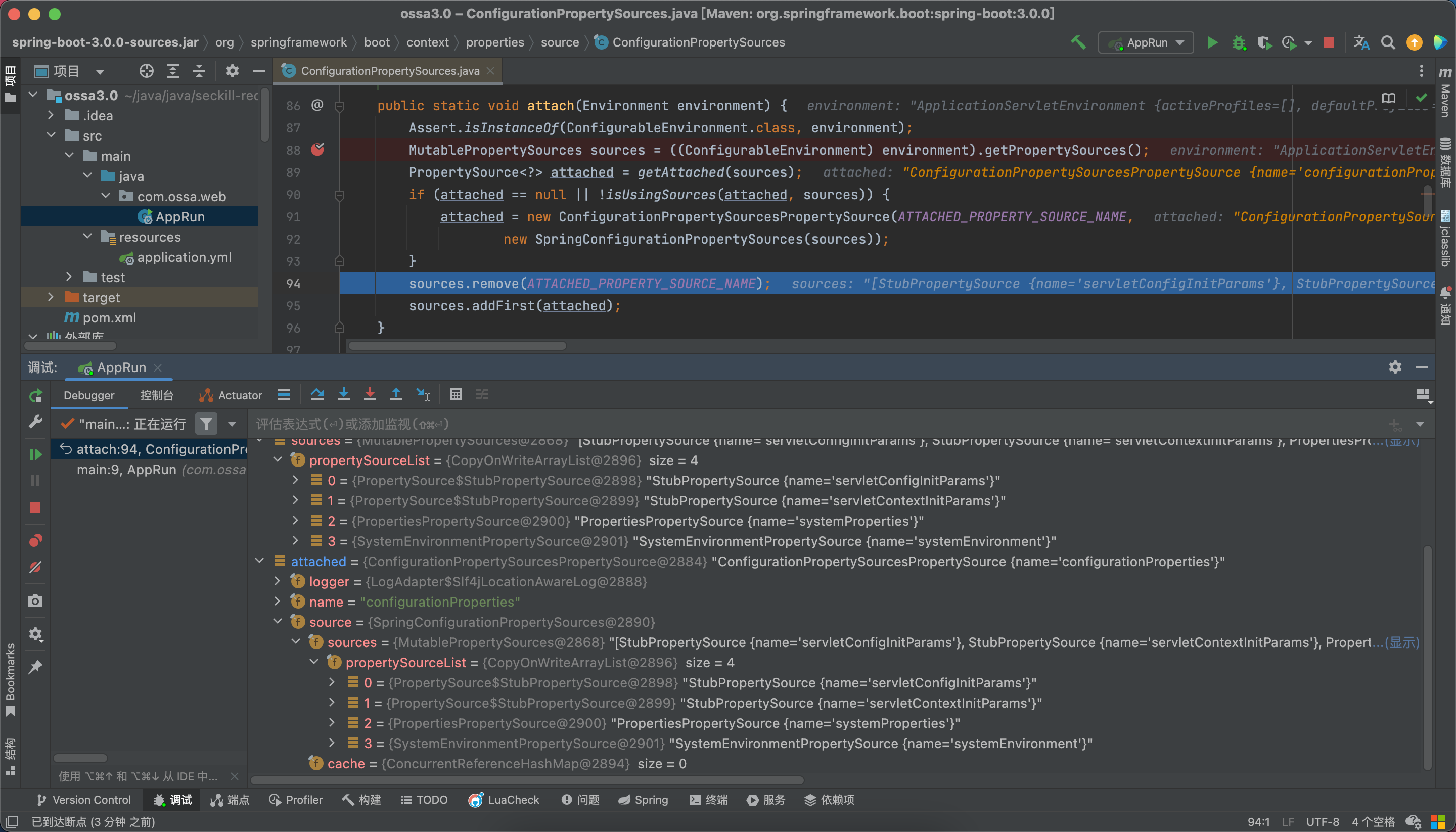
// 发布了ApplicationEnvironmentPreparedEvent的监听器,读取了全局配置文件
listeners.environmentPrepared(bootstrapContext, environment);
最终调用onApplicationEnvironmentPreparedEvent方法:
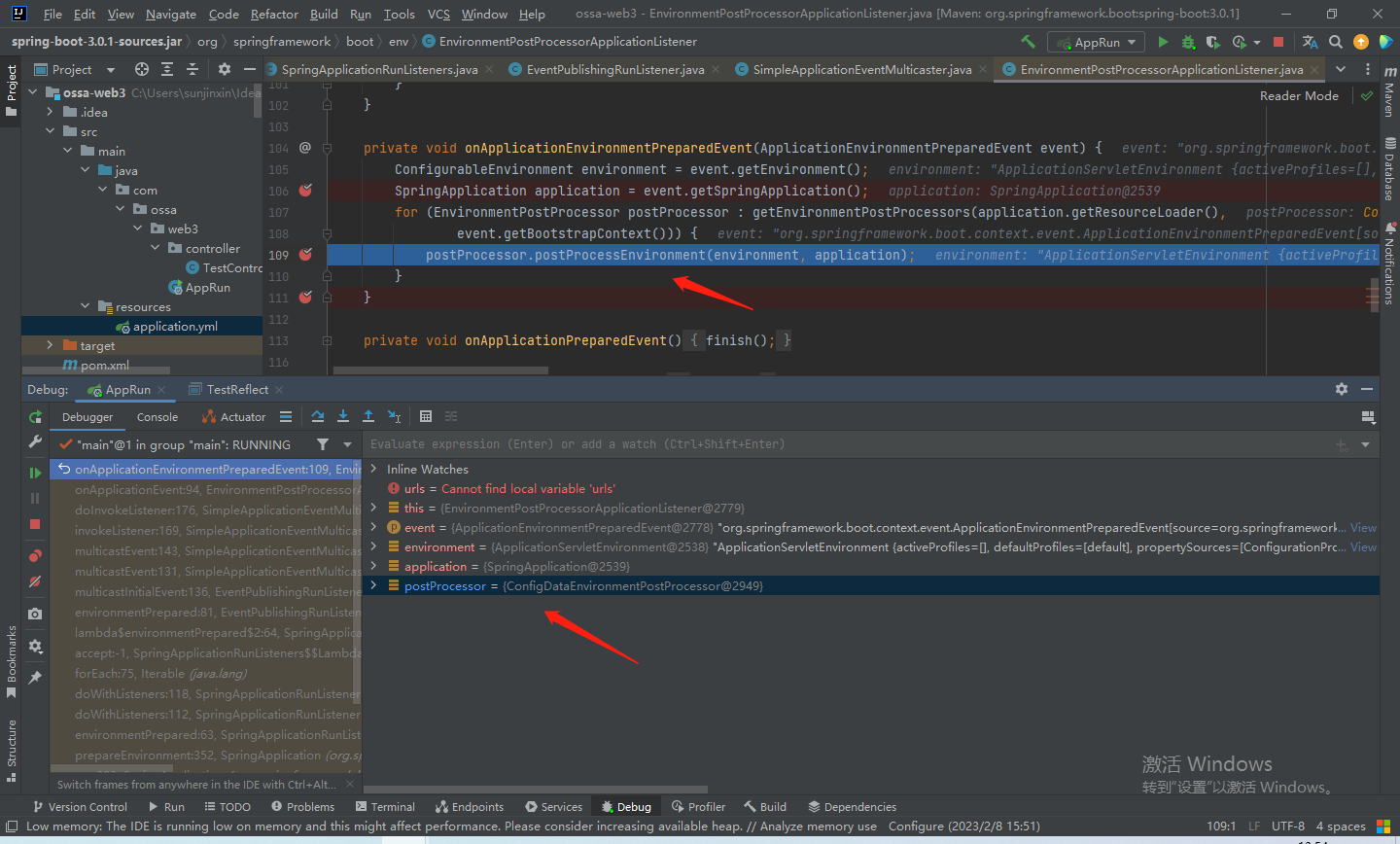
步入postProcessEnvironment方法:

步入processAndApply方法:
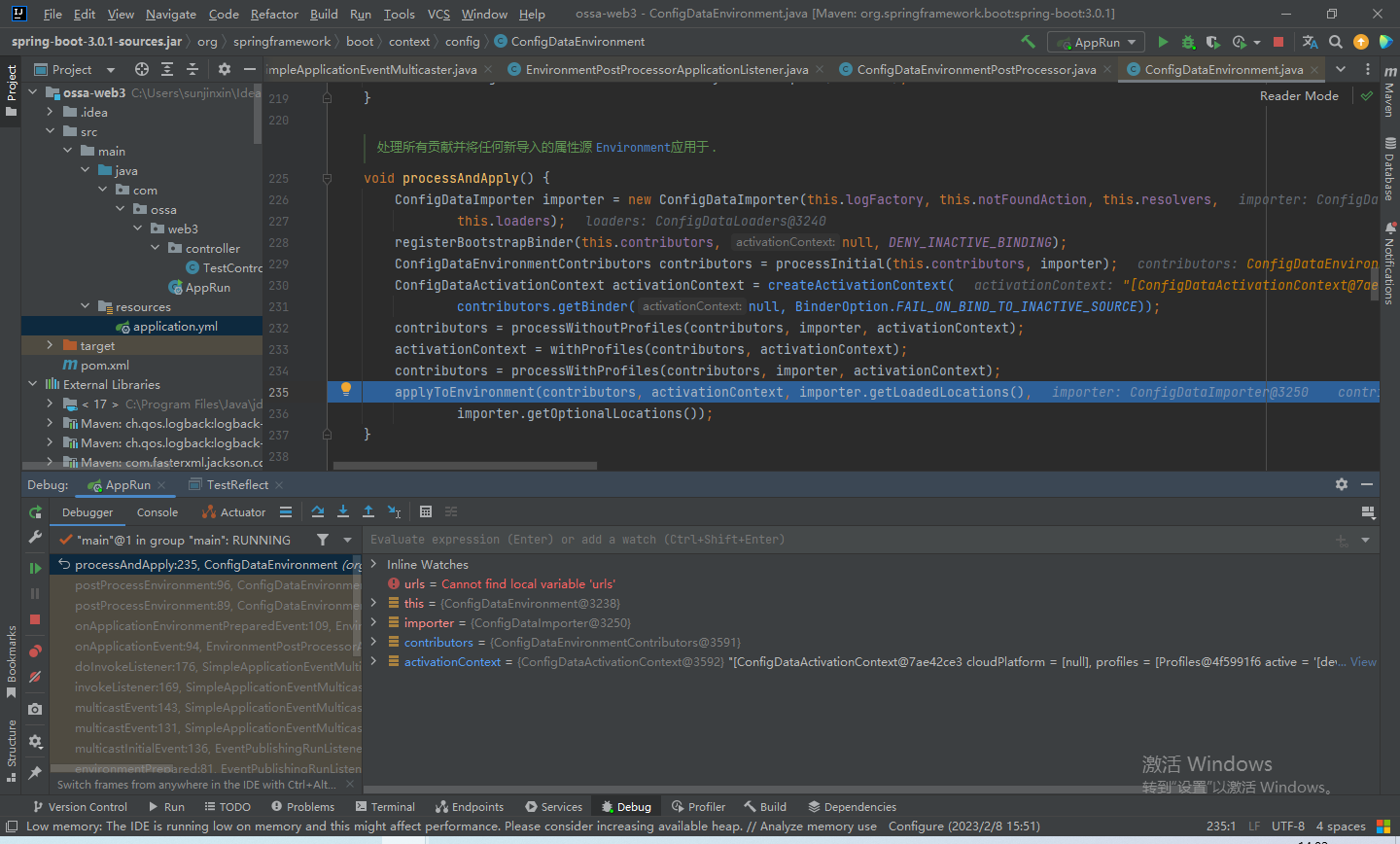
步入applyToEnvironment方法:
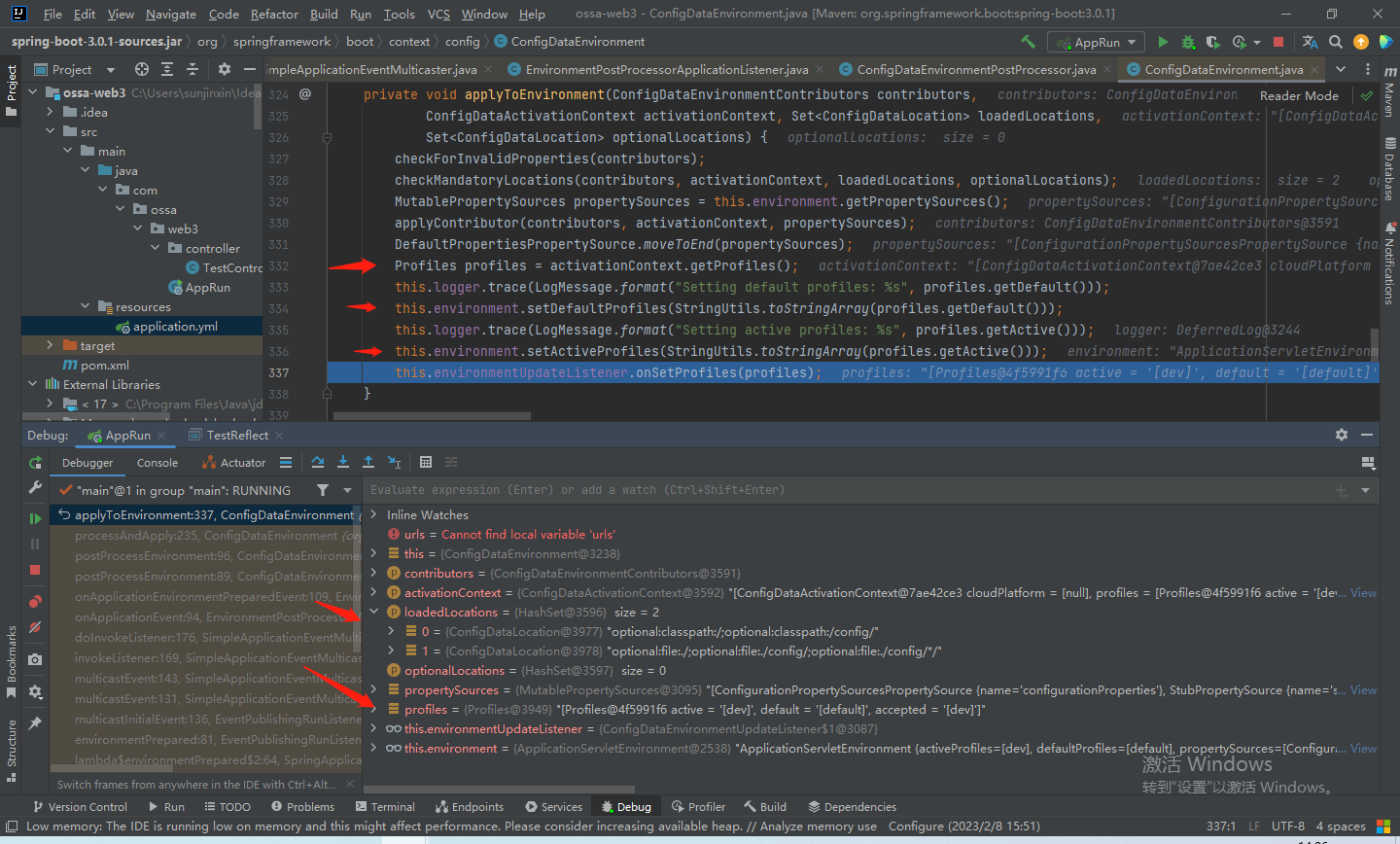
// 将所有spring.main 开头的配置信息绑定到SpringApplication中
bindToSpringApplication(environment);

打印Banner
// 打印Banner
Banner printedBanner = printBanner(environment);
步入printBanner方法:
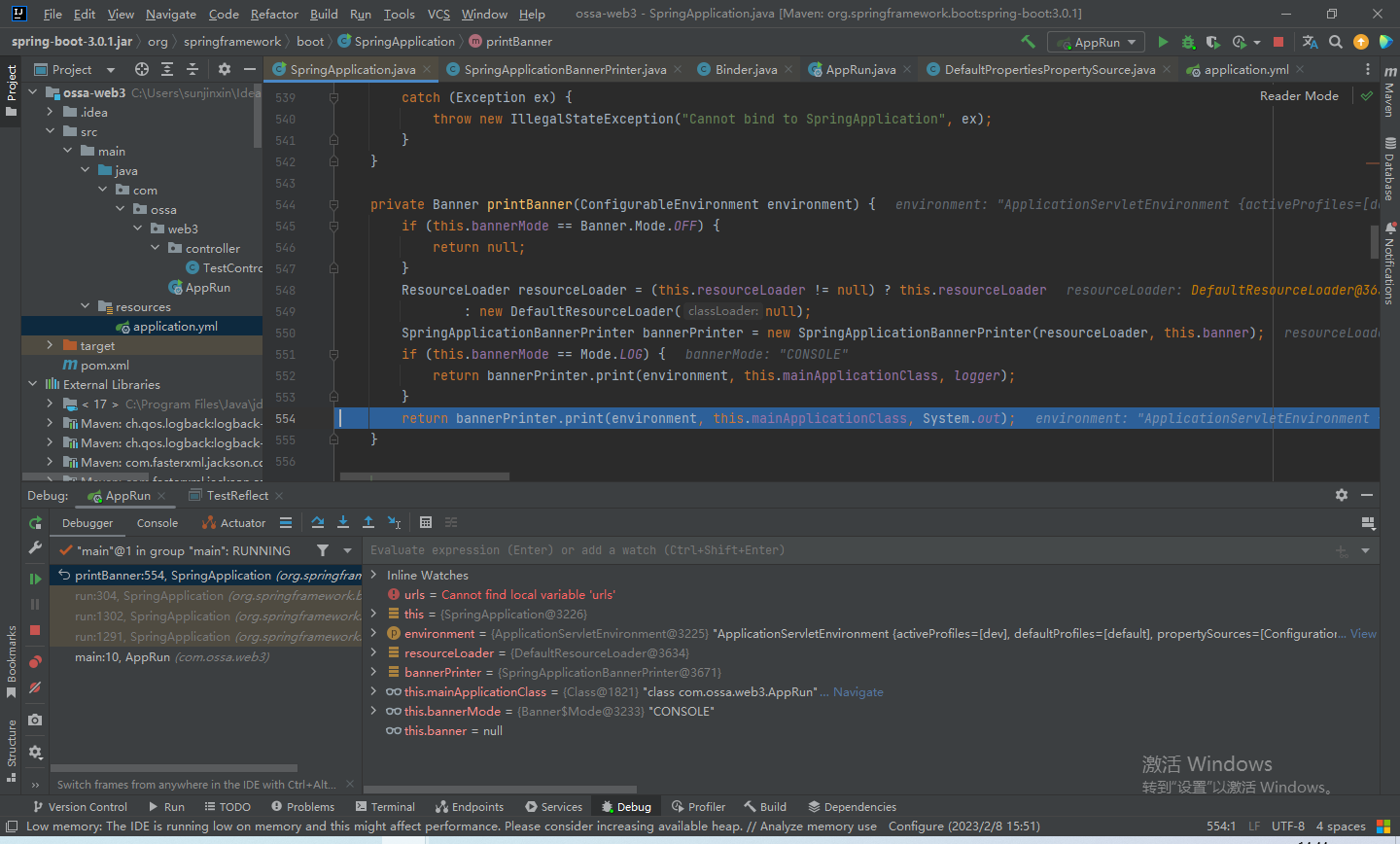
步入print方法:

步入getBanner方法:
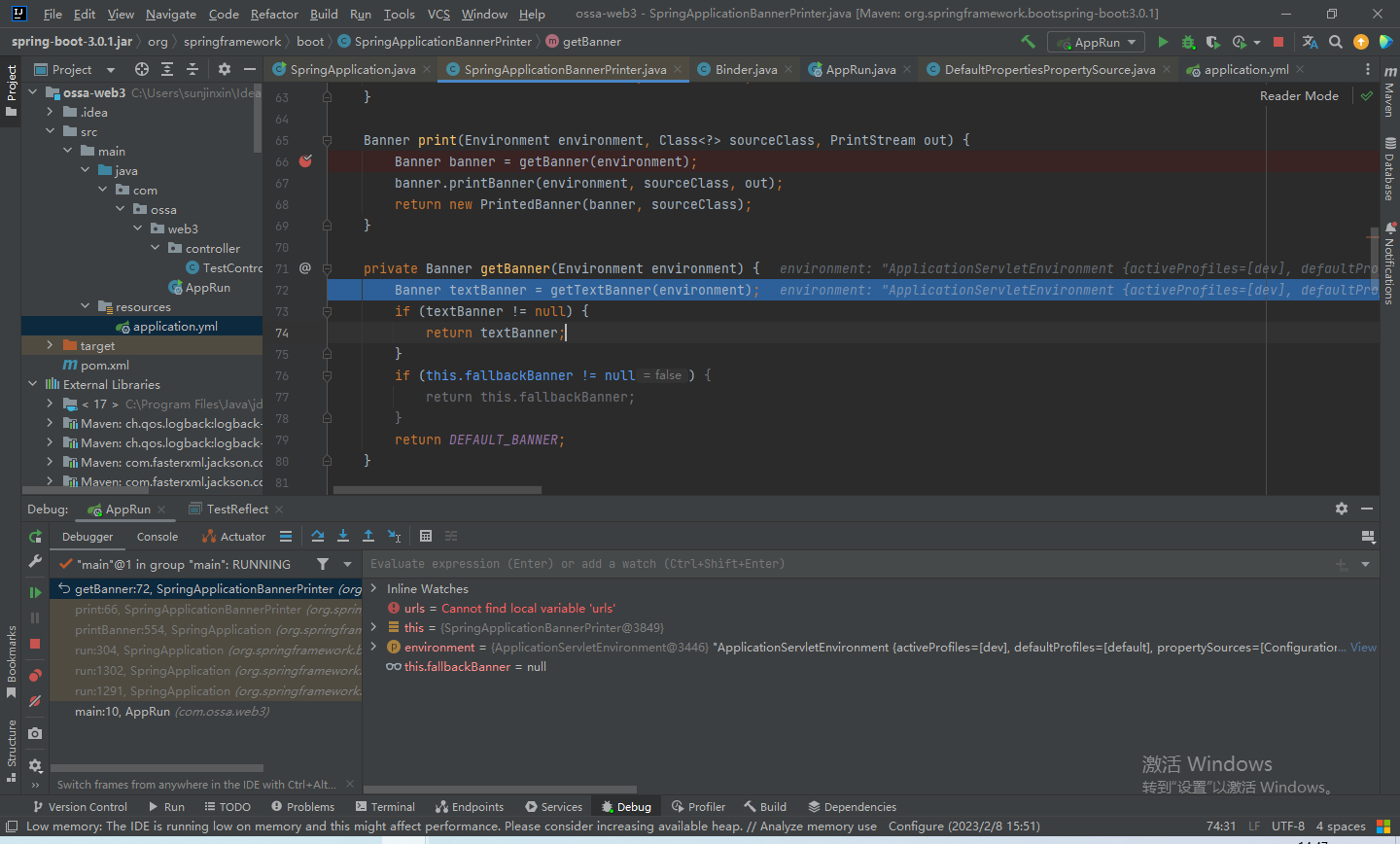
步入getTextBanner方法:首先获取spring.banner.location的值,如果没有就默认在根路径下,输出banner.txt文件。
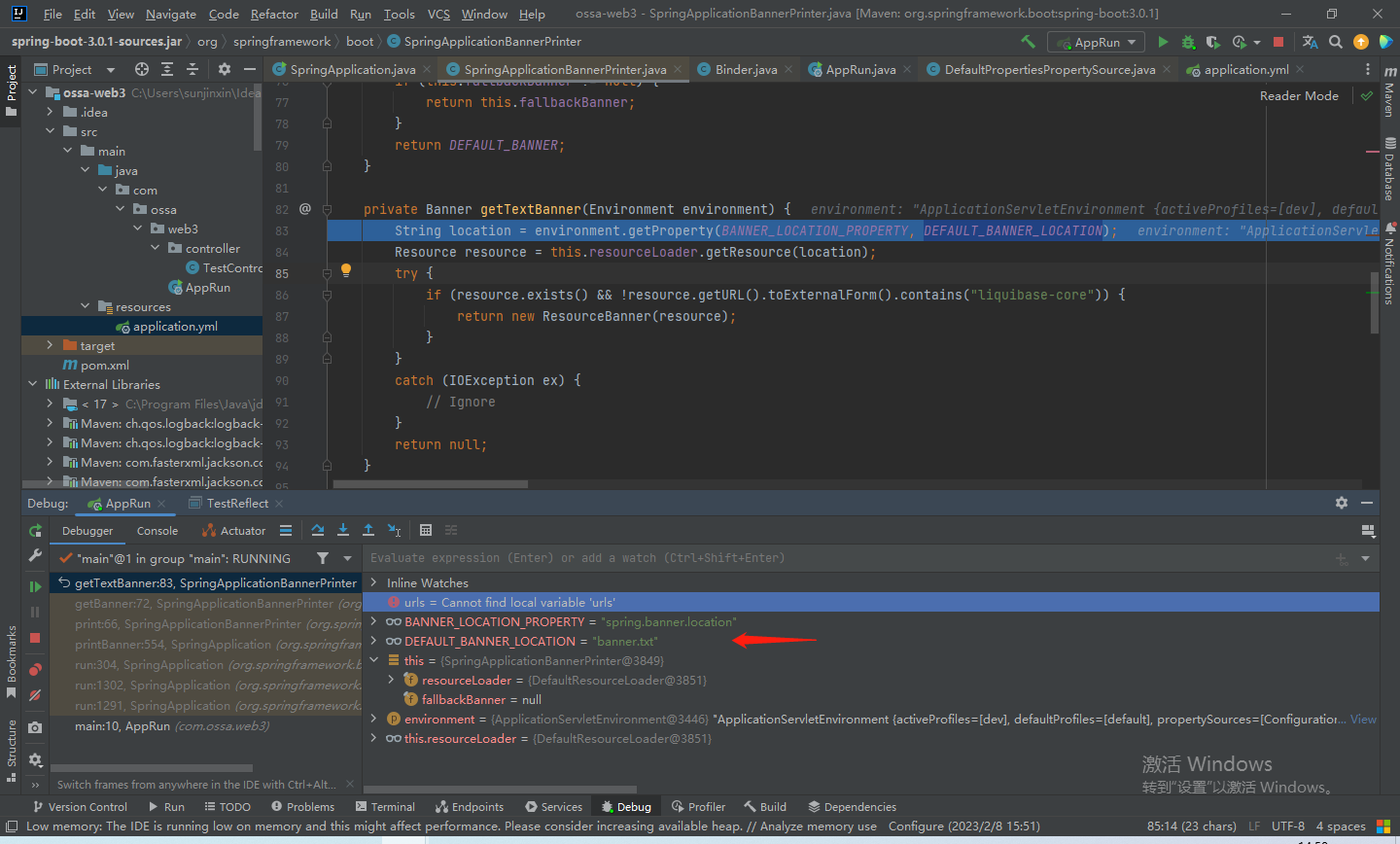
获取完banner后,会输出:
banner.printBanner(environment, sourceClass, out);

步入该方法,输出banner:
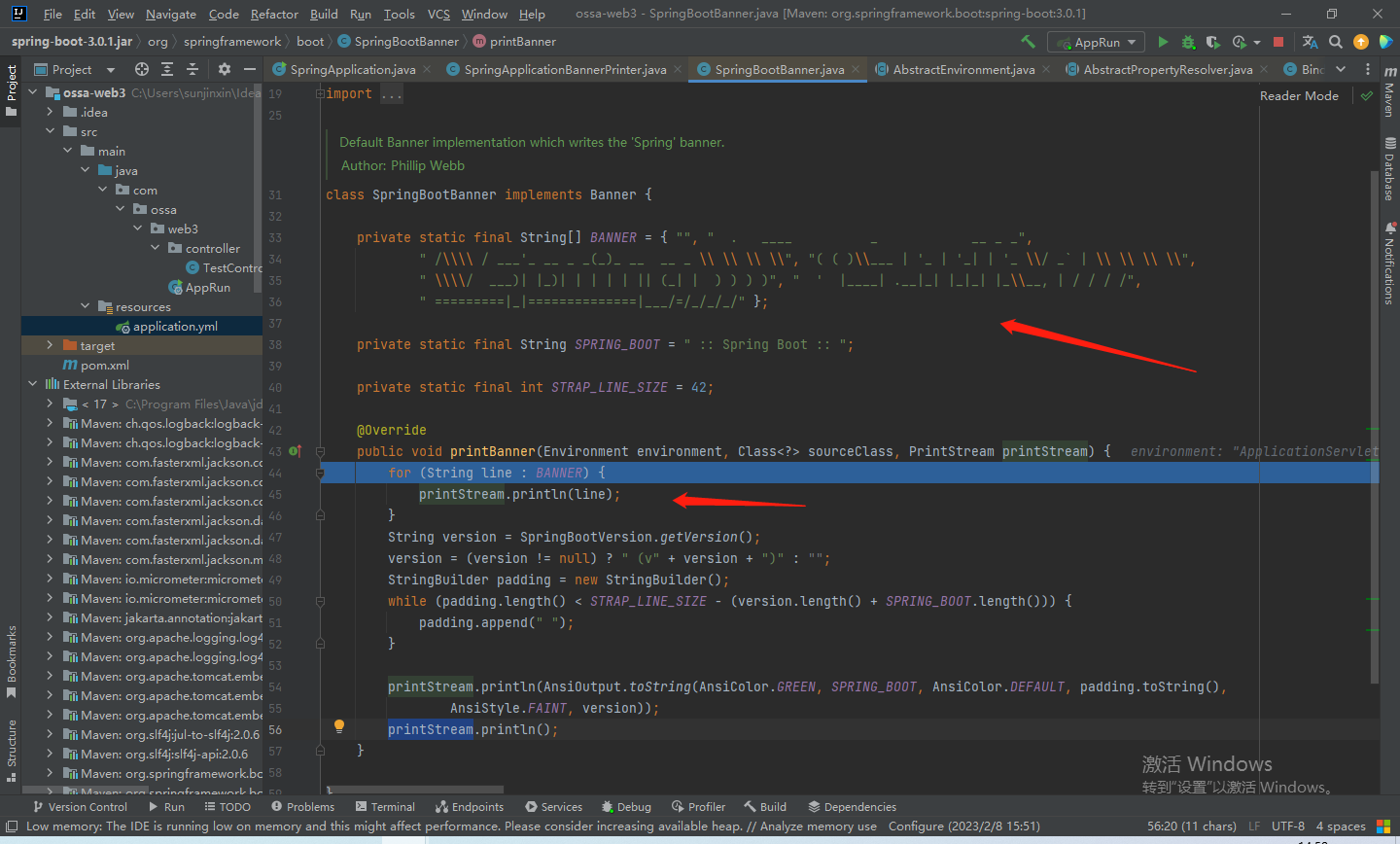
创建上下文容器
// 据webApplicationType创建不同的Spring上下文容器(有三种)
context = createApplicationContext();
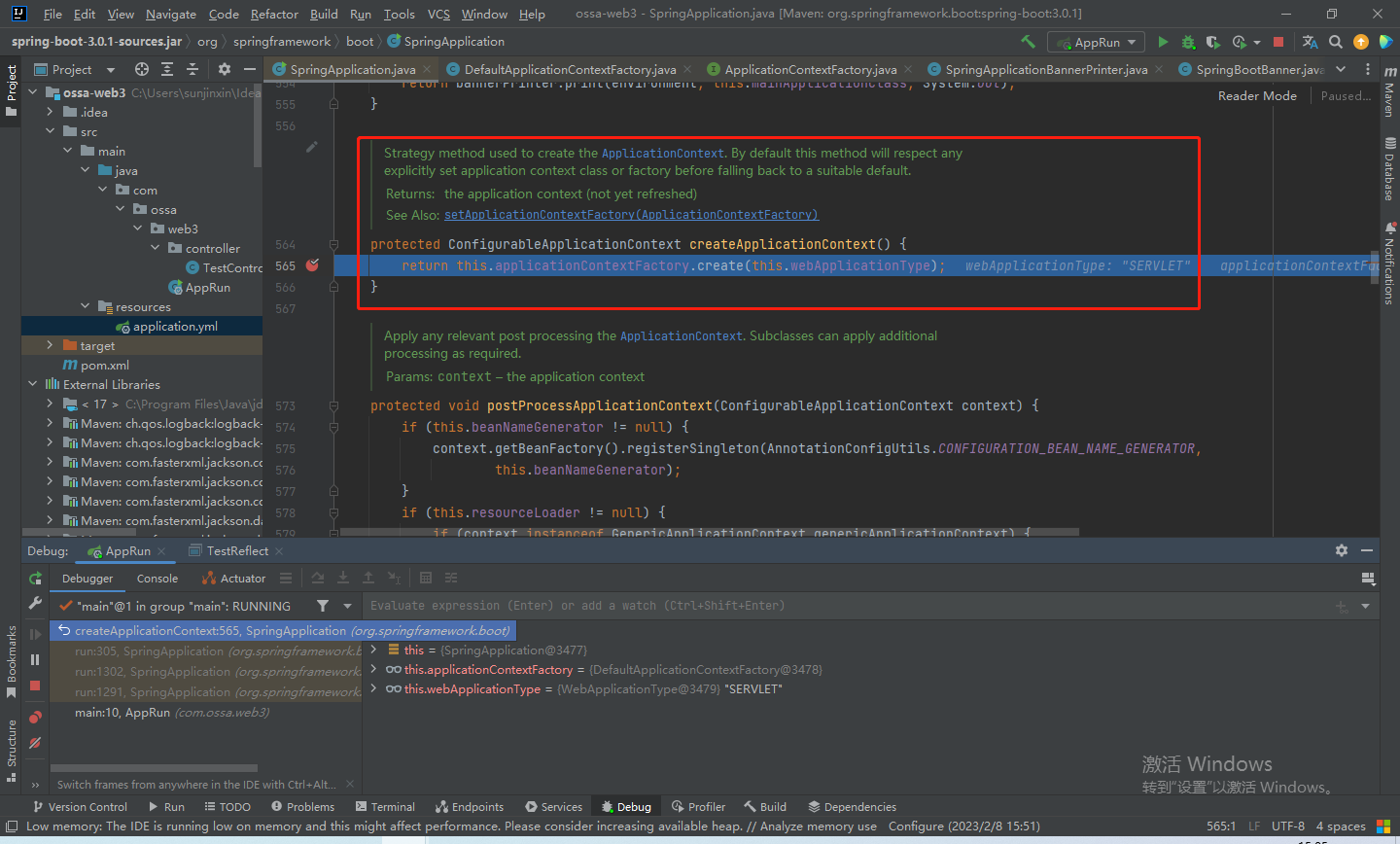
预初始化上下文容器
prepareContext(bootstrapContext, context, environment, listeners, applicationArguments, printedBanner);
步入prepareContext方法:
首先获取所有ApplicationContextInitializer, 循环调用initialize方法。
获取beanFactory。
对bean进行check,如果有重复的bean就会抛出异常。
将启动类注册到Spring容器中。
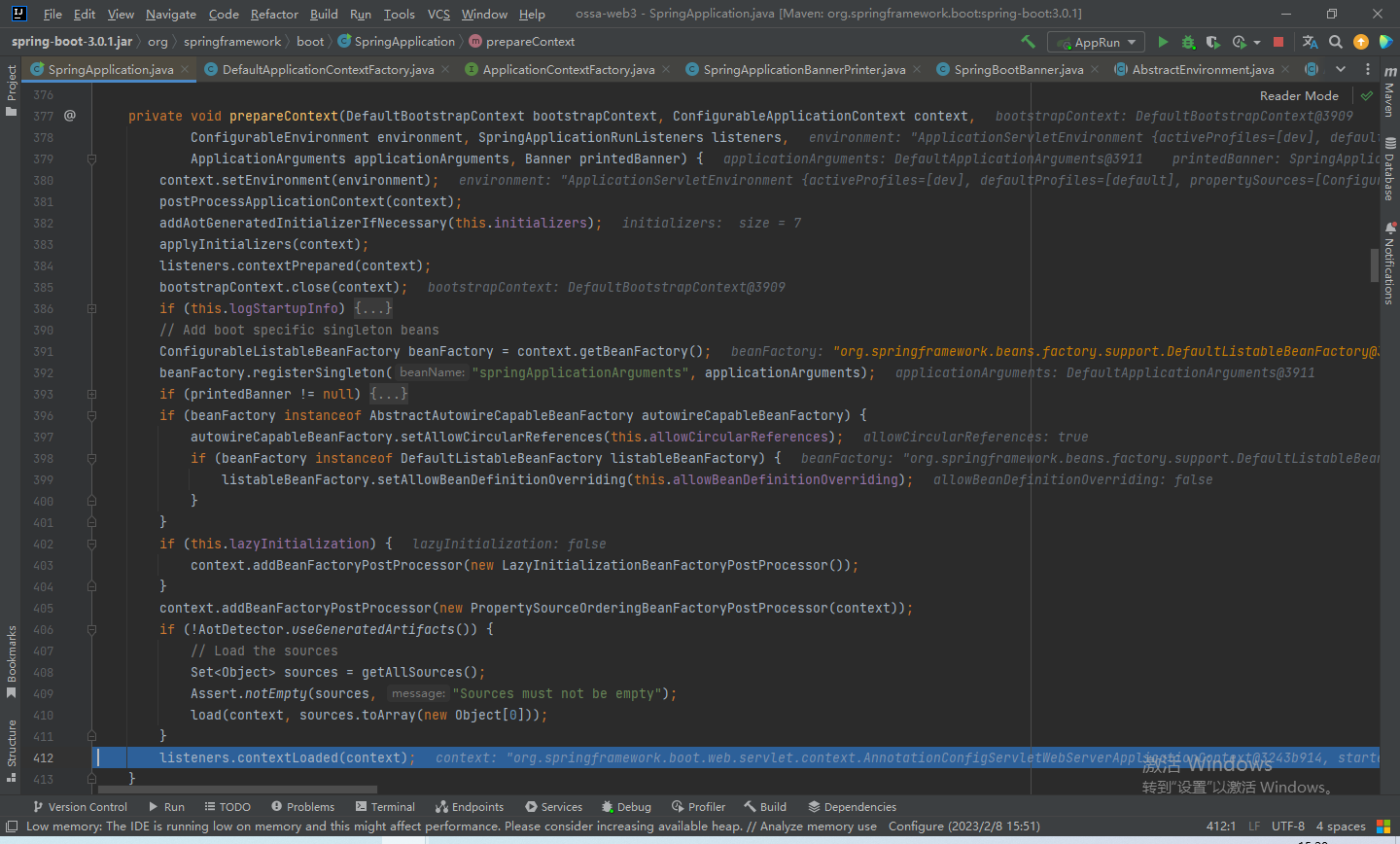
刷新Spring容器
这里前几章文章重点讲的,包括bean的加载、实例化、初始化、aop、事务、tomcat启动。
可以移步专栏查看:
打印启动时间
Duration timeTakenToStartup = Duration.ofNanos(System.nanoTime() - startTime);
if (this.logStartupInfo) {
new StartupInfoLogger(this.mainApplicationClass).logStarted(getApplicationLog(), timeTakenToStartup);
}
发布事件
// 发布ApplicationStartedEvent事件和AvailabilityChangeEvent事件
listeners.started(context, timeTakenToStartup);
最终来到这个方法进行事件的发布:
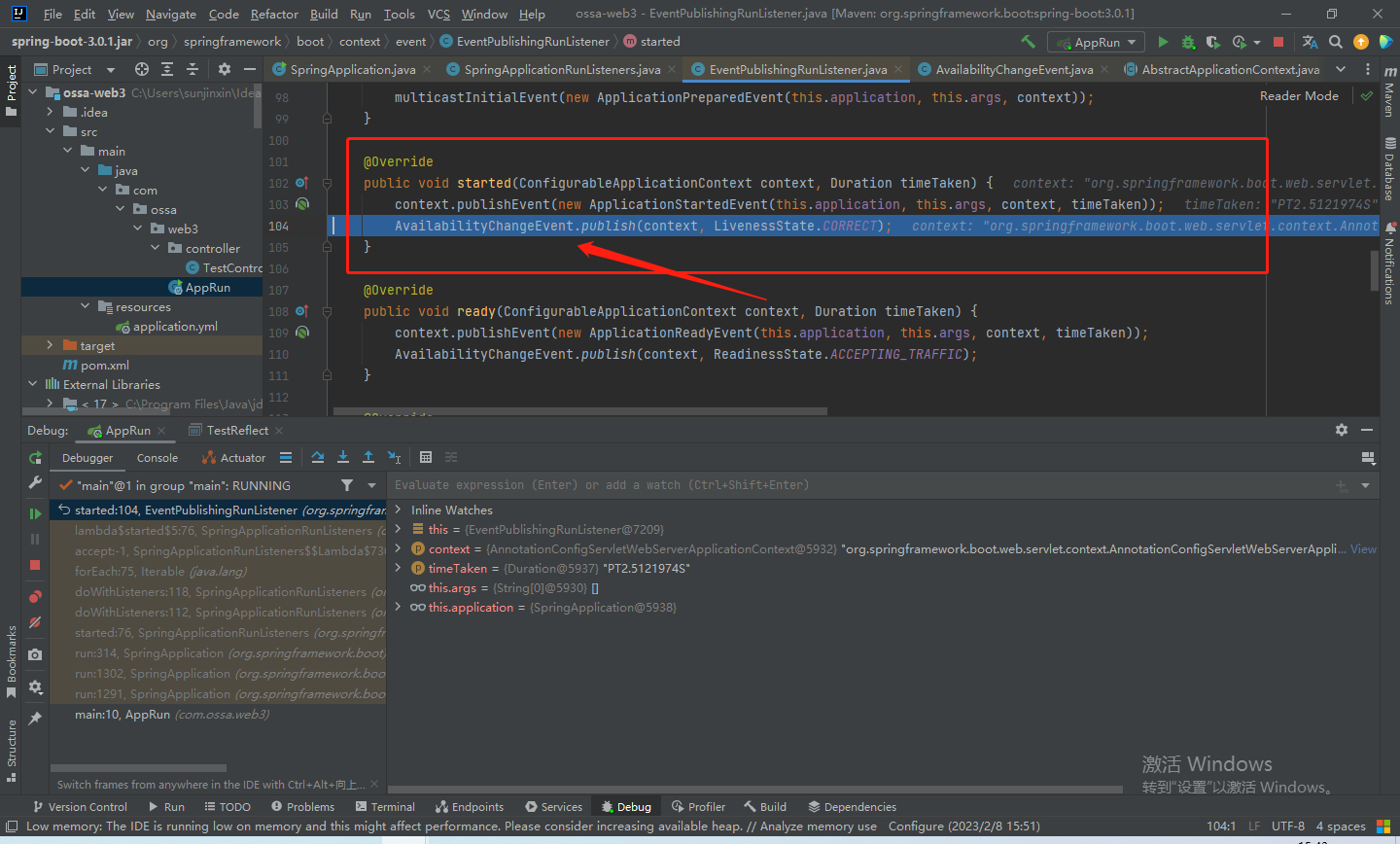
最终进行发布:
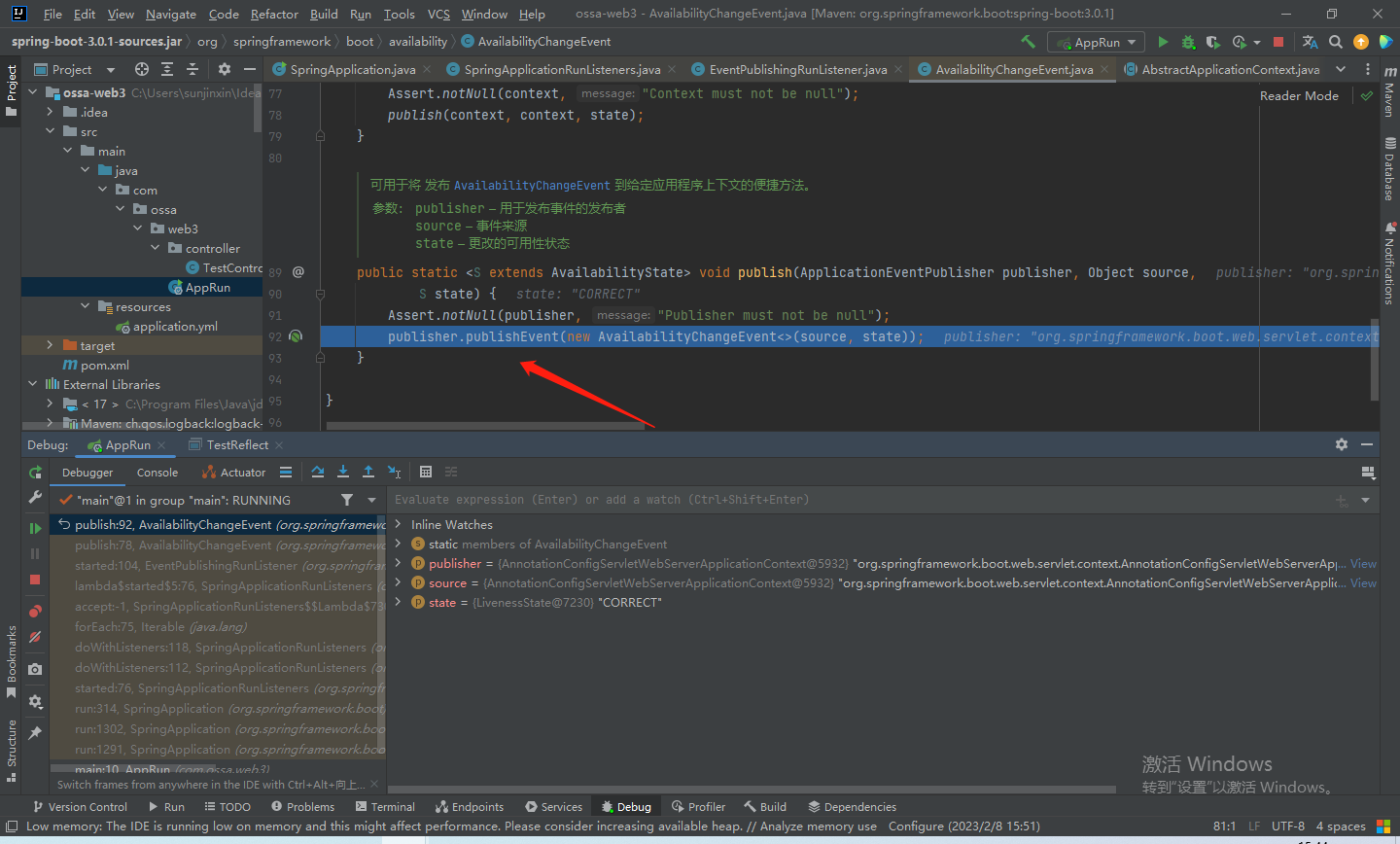
执行特定的run方法
// 获取Spring容器中的ApplicationRunner/CommandLineRunner类型的Bean,并执行run方法
callRunners(context, applicationArguments);
ApplicationRunner和CommandLineRunner简介
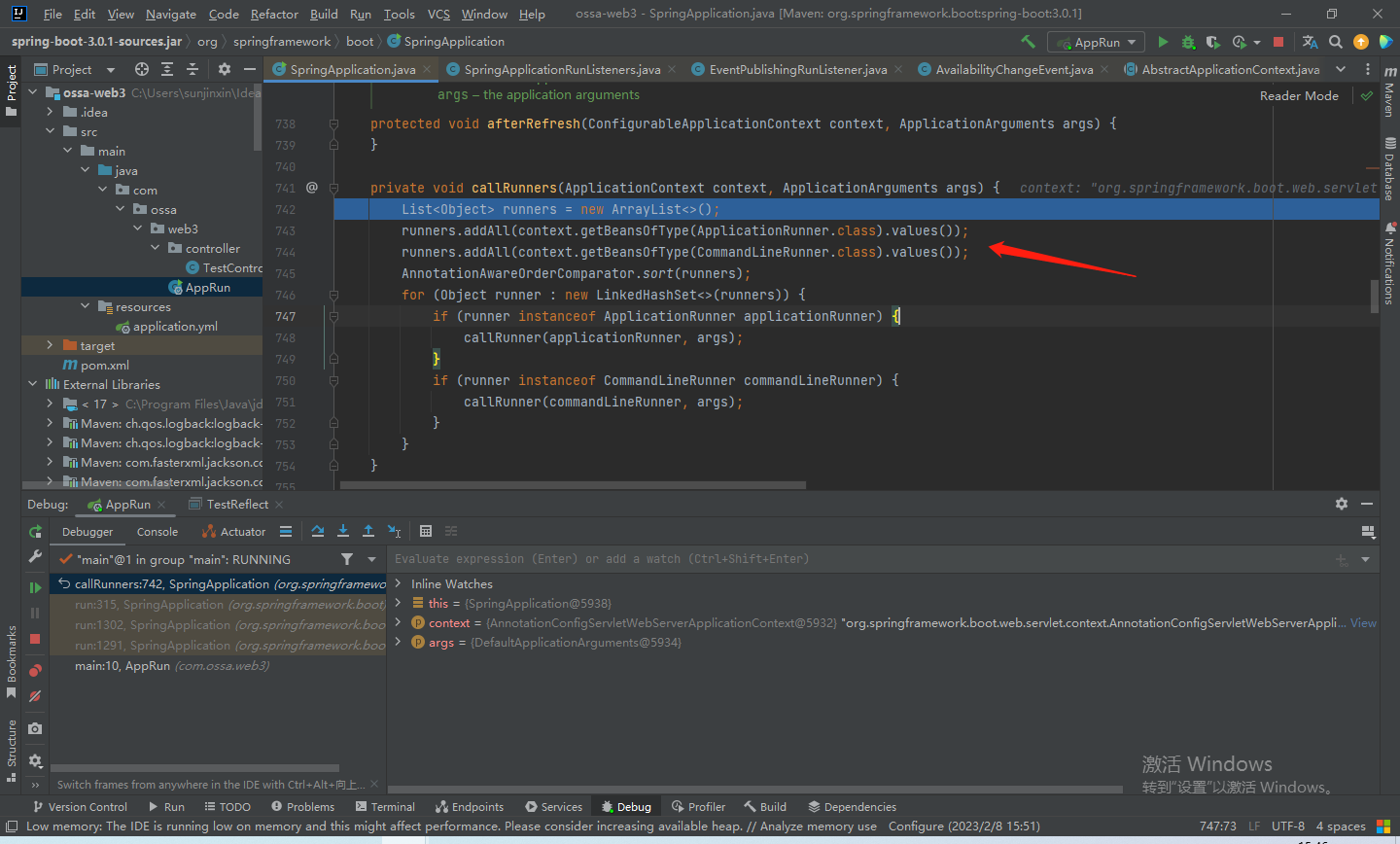
后续就是发布ApplicationReadyEvent事件和AvailabilityChangeEvent事件,以及对异常的处理。